Hover or touch on unknown words to show its meaning.
Try it here: “HorologyHorology The study of timekeeping.”
Sections are rated (0 to 3) for technical content. Use “Skip” to avoid too technical sections.
Up on the bench today is a scrappy SeikoSeiko A Japanese manufacturer of watches. ActusActus Seiko's Japanese domestic market lower end brand of the 70s. I inadvertently bought at an online Japanese auction having neglected to cancel my lowballLowball A very low offer, or bid, for an item for sale. snipeSnipe An auction bid that is automatically placed at the very last second of an auction. bid. With no other takers, I walked away with it at the starting price, although shipping costs to New York, via Tokyo, totaled considerably more than the hammer priceHammer price The final cost of an item at auction, excluding tax and shipping.. Even so, the appeal of that Japanese day wheelDay wheel A rotating disk, printed with the days of the week, one of which is visible thru a window on the dial. made it all worthwhile.
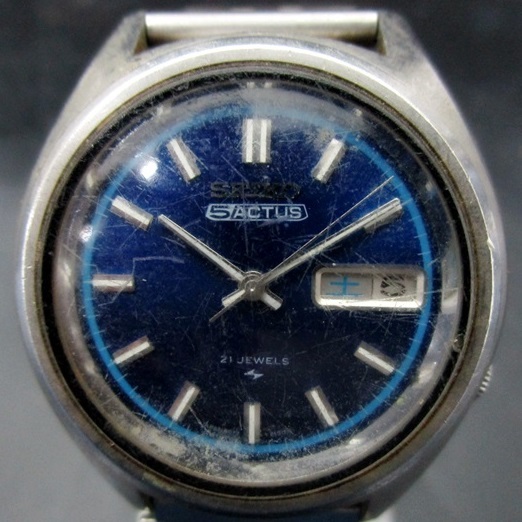
I’ve included the auction photo here (on the shaky legal premise that in purchasing the item I also gained copyright to its image) so you too can see it as I did on that blurry Sunday morning.
The Google-translated description of ‘junk’, ‘scratched windshield’, and ‘unoriginal belt’, was a little harsh (while simultaneously endearing) as, once delivered, unwrapped, and de-casedDe-cased The watch movement is removed from the watch case., it was all aglow…
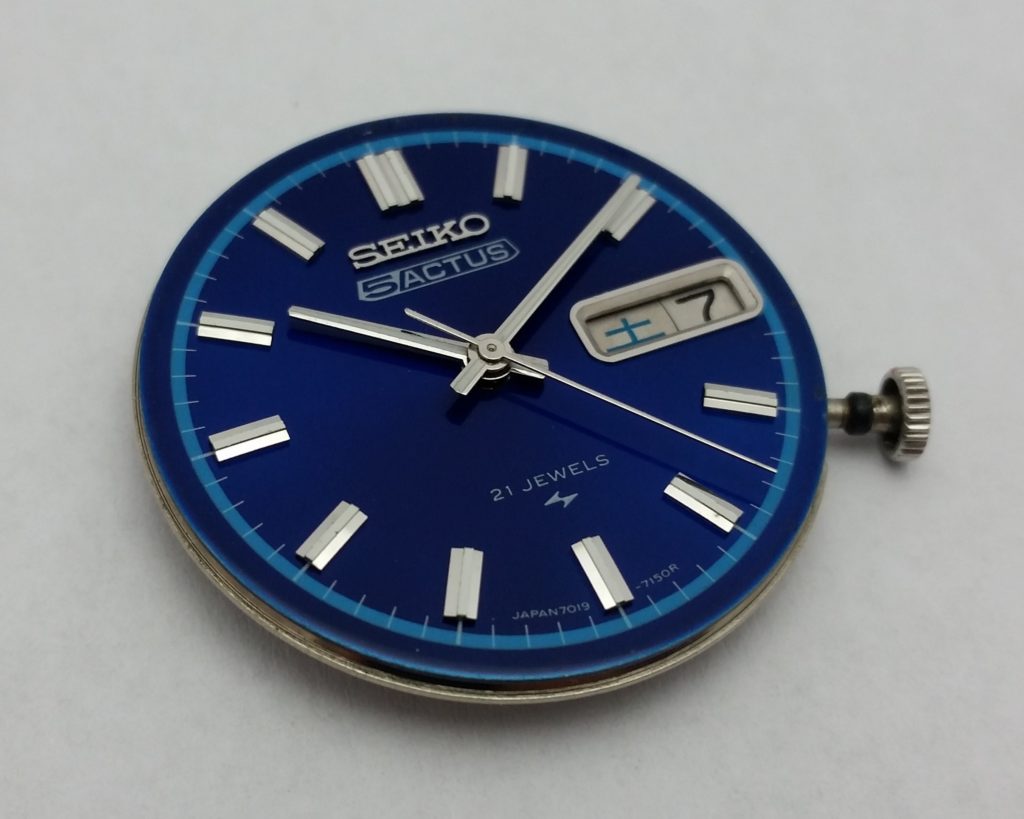
The bright blue minute track adds a vivid highlight, matching the kanjiKanji The adopted logographic Chinese characters that are used in the Japanese writing system. day wheelDay wheel A rotating disk, printed with the days of the week, one of which is visible thru a window on the dial. – but only on Saturdays!
As an added bonus, the signature of a Japanese watchmakerWatchmaker The craft of repairing watches.
It's known as 'making' rather than 'repairing' as early artisans would buy the components separately and make new watches from scratch. That's all done in the factory now, but the name stuck.’s serviceService The watch is dismantled, cleaned, re-oiled and reassembled. Necessary for accurate timekeeping, and to prevent wearing of parts. was evident inside the casebackCaseback The back cover of a watch, usually removable to access the inner workings., but alas, so too was the telltale scarring of a loose rotorRotor A weighted pendulum that moves as the user swings their arm, causing the mainspring to be wound on an automatic watch. at the bullseye and circumference:
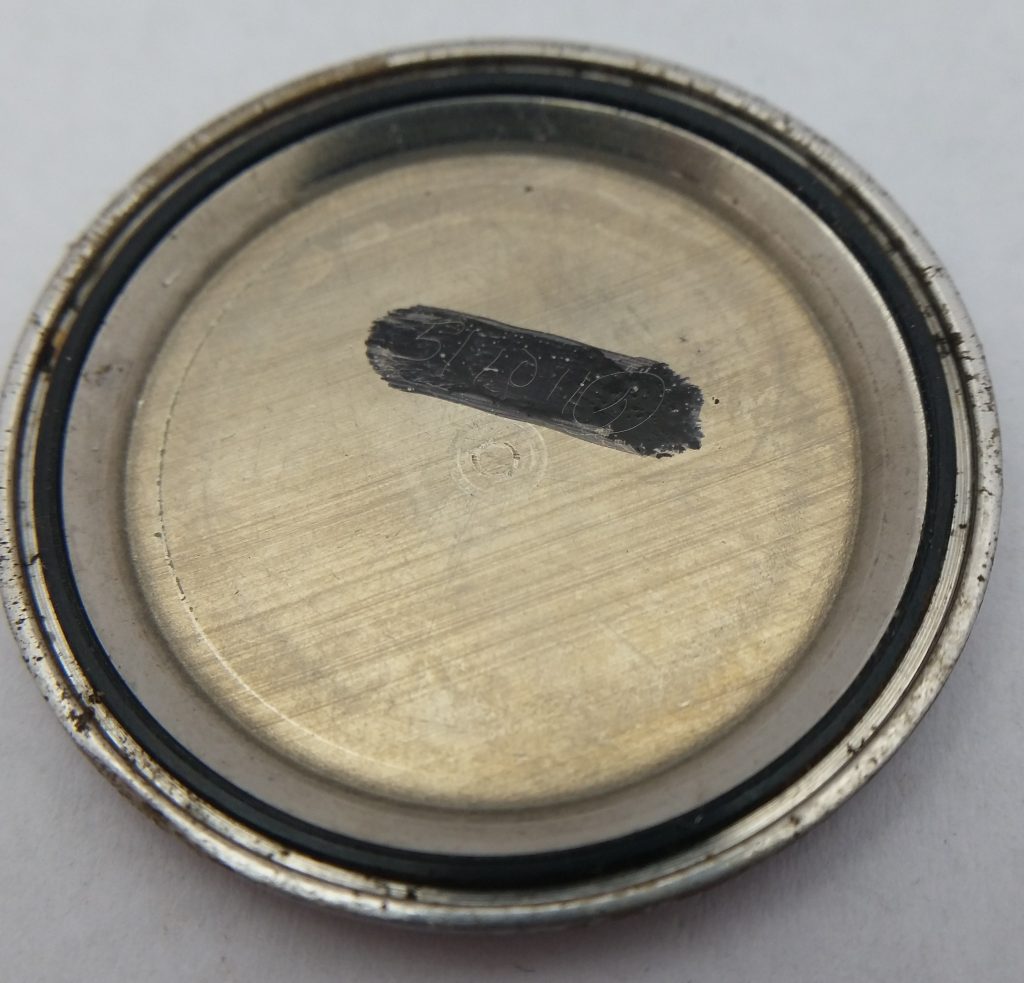
A blast in the ultrasonic cleanerUltrasonic A machine that shakes loose dirt and grease by vibrating the cleaning fluid at very high frequency. will clean this up nicely.
As best I can make it out, the inscription reads 511011, which I’d hazard indicates the 11th of October, 1976 (the 51st year of ShōwaShowa The period of Japanese history corresponding to the reign of Emperor Shōwa (Hirohito) from December 25, 1926 until his death on January 7, 1989.
Traditional Japanese dates number the years since the coronation of the emperor. era in the traditional Japanese calendar system), and that ties in neatly as a 5 year serviceService The watch is dismantled, cleaned, re-oiled and reassembled. Necessary for accurate timekeeping, and to prevent wearing of parts. after the manufacture date of June or Sept 1971 – decoded from the serial numbers on the dialDial The visible face of the watch. and case backs:
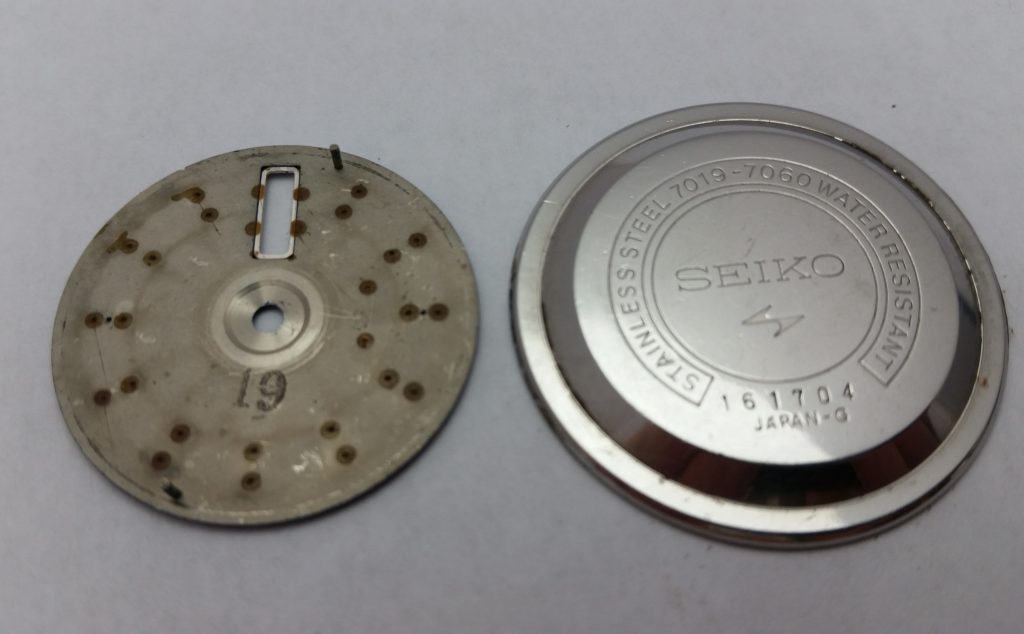
SeikoSeiko A Japanese manufacturer of watches. had launched the world’s first quartzQuartz A watch that derives its timekeeping from the electrical vibrations of quartz crystal. Accurate and cheap. wristwatch in 1969, but they were still priced at the luxury end of the market as this watch rolled off the production line in 1971. By the time of that first serviceService The watch is dismantled, cleaned, re-oiled and reassembled. Necessary for accurate timekeeping, and to prevent wearing of parts. in 1976 though, the tide had turned and quartzQuartz A watch that derives its timekeeping from the electrical vibrations of quartz crystal. Accurate and cheap.-powered watches, with their futuristic digital displays, were more modern, more accurate, and now cheaper than their automatic watchAutomatic winding A mechanical watch that does not need winding, instead deriving it's power from the movement of it's wearer. brethren of yesteryear. Someone dutifully paid for that 5-year serviceService The watch is dismantled, cleaned, re-oiled and reassembled. Necessary for accurate timekeeping, and to prevent wearing of parts., but that was to be its last, no doubt relegated to some dusty drawer by the eighties, where it lay in a 40-year slumber – from which it shall duly be reawoken this very day.
I’ll spare you all the details of an uneventful strip downStrip down Separate the watch into all its constituent parts., and get straight to the glory of the Part ArtPart Art The laying out of all the components of a watch prior to rebuilding, preferably in an interesting or eye-catching arrangement. Totally pointless, and a real time suck.:
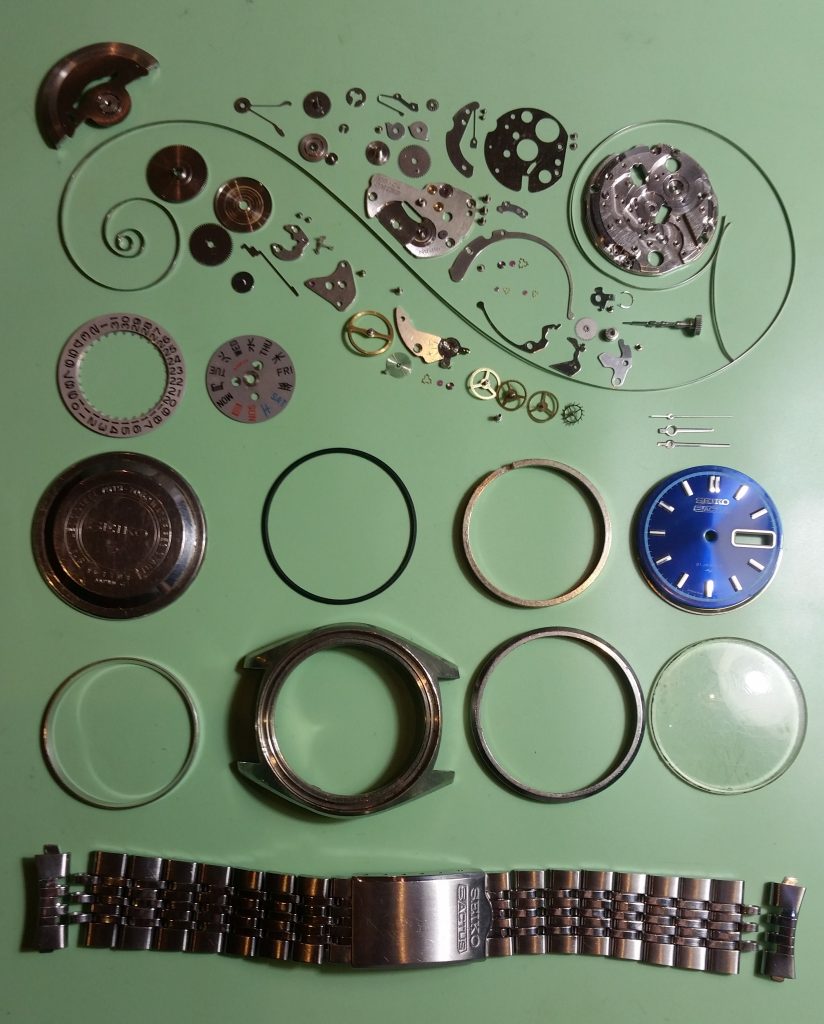
The Build : technical level 1 (click to skip)
Share this section:
Tradition dictates that the keyless worksKeyless works The collection of levers, springs, and pinions that allow the wearer to wind, adjust or stop the watch via the crown.
Clocks, and older watches, require a key to wind, hence the name of this improved system. go in first, although this is not really necessary as the 7019 movementMovement A noun, referring to the whole of the inner workings of a watch. Not a great choice of word, in my opinion. does not hackHack The second hand is brought to a stop, usually by pulling out the crown one or two stops. The minute and hour hands can be re-positioned, and then the crown returned at the exact correct time so the watch resumes ticking.
A standard feature on all but the most basic of watches. (tsk, tsk!), but why not, as I’m refitting the jewelingJewel Synthetic ruby insert that is used as a bearing. Low friction and resistance to wear. Usually purple. on this side anyway.
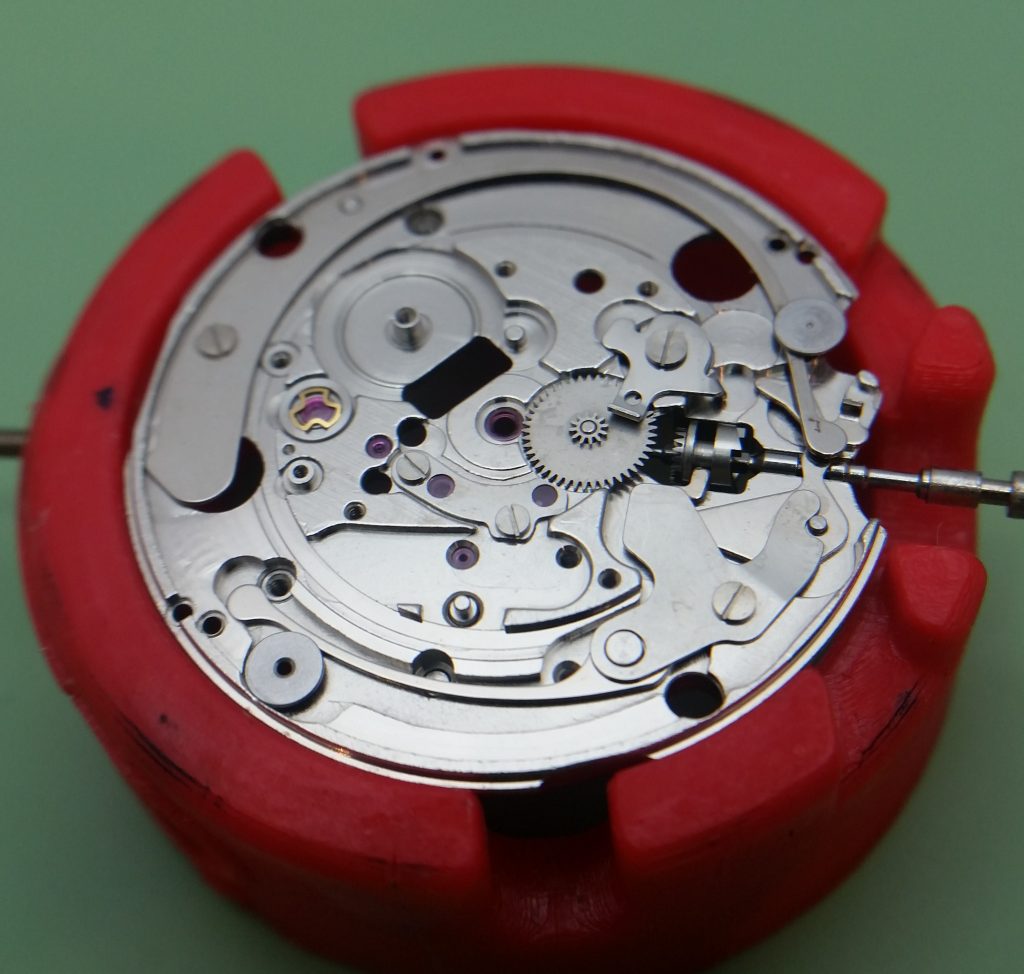
The lower end-piece (crescent, just below center), containing two jewelsJewel Synthetic ruby insert that is used as a bearing. Low friction and resistance to wear. Usually purple. for escapeEscape wheel A curiously shaped wheel whose rotation stops and starts, allowing tiny amounts of power to 'escape' from the mainspring at uniform intervals, thus driving the hands.
Barrel - center wheel - third wheel - fourth wheel - escape wheel.
Generally, the fastest fully rotating wheel in a watch, rotating every 5 seconds or so. and third wheelsThird Wheel Third in line of the geared power train:
Barrel - center wheel - third wheel - fourth wheel - escape wheel. is a real timesaver over the diafixsDiafix Seiko's cap jewel retaining spring system. Have a reputation for being fiddly. favored by other SeikoSeiko A Japanese manufacturer of watches. hi-jeweledJewel Synthetic ruby insert that is used as a bearing. Low friction and resistance to wear. Usually purple. trains – just two straightforward screws rather than troublesome springs, but, on the downside, totally inflexible. Then the diashockedDiashock Seiko's shock absorbing spring and jewel system. balance wheelBalance Wheel A spring driven flywheel that rotates back and forth, acting as a pendulun to regulate the timekeeping. jewelJewel Synthetic ruby insert that is used as a bearing. Low friction and resistance to wear. Usually purple. is clipped in, prior to oiling them all from the other side of the main plateMain plate The disk upon which all the watch's working parts are mounted..
A little lubrication is applied to the bearing surfaces ( not the pinionPinion A small cog - the teeth are referred to as leaves. teeth ) of the center wheelCenter wheel The second wheel in the power train.
Barrel - center wheel - third wheel - fourth wheel - escape wheel.
Takes its name from being in the center of the watch.
Connected to the minute hand, it completes one rotation every hour.…

… prior to its placement in pole positionPosition Usually refers to a specific orientation of the watch. Timekeeping is optimized in multiple positions (usually up to 6) in the hope that during everyday wear the watch will keep some average of all measurements. in the main plateMain plate The disk upon which all the watch's working parts are mounted., secured by its bridgeBridge A flat plate that secures other components in place. Usually screwed down with two or more screws..
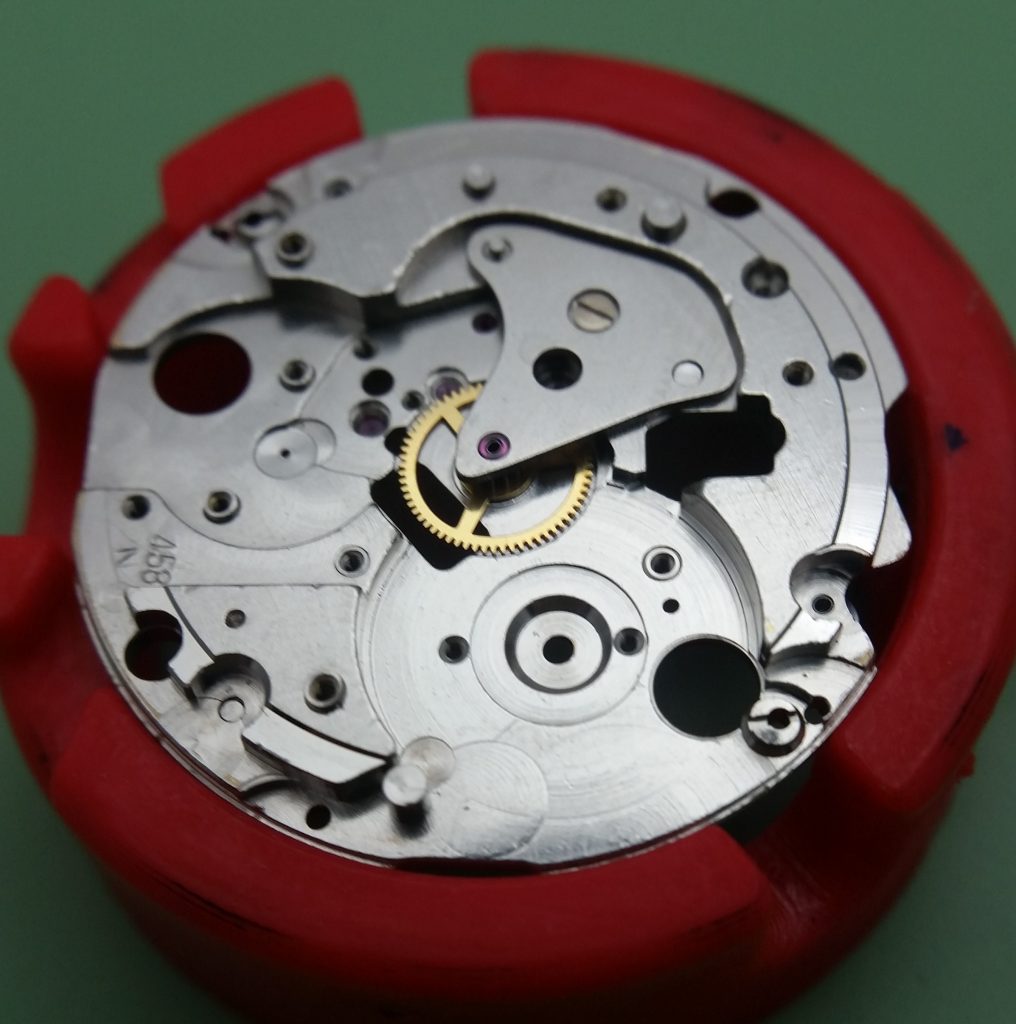
At this point it’s wise to flip the movementMovement A noun, referring to the whole of the inner workings of a watch. Not a great choice of word, in my opinion. over briefly and attach the cannon pinionCannon pinion A critical part that connects together the working parts on both sides of the main plate. Often, the minute hand is connected directly to it. It's carefully designed to be able to slip when the wearer adjusts the time, so as to isolate all the ticking parts., lest the incoming fourth wheelFourth Wheel Fourth in line of the geared power train:
Barrel - center wheel - third wheel - fourth wheel - escape wheel.
Confusingly named - the second hand is usually driven by the fourth wheel.
One full turn every minute. staff pivotPivot The tip of the staff (axle), usually rests within/upon a jewel. should get pranged if the movementMovement A noun, referring to the whole of the inner workings of a watch. Not a great choice of word, in my opinion. slips from its holder.
Up next – the mainspringMainspring A coiled up steel spring that provides the main power source of the watch., having been cleansed of decades of congealed black grease, is wound up…

… and pressed back into its barrelBarrel Contains the mainspring, and acts as the first wheel in the train.
Barrel - center wheel - third wheel - fourth wheel - escape wheel.
One full rotation every 7 hours or so.. Greasing protocols have evolved since the 70s, so it receives just a thin application of braking greaseBraking grease Designed to prevent overwinding of the mainspring in automatic watches. on the inner rim and a sparse coating of modern synthetic oilSynthetic Oil Designed in the laboratory, rather than naturally occurring, with far longer working life. to the inner sides and arborArbor Rotating shaft (axle), usually in reference to the mainspring barrel..
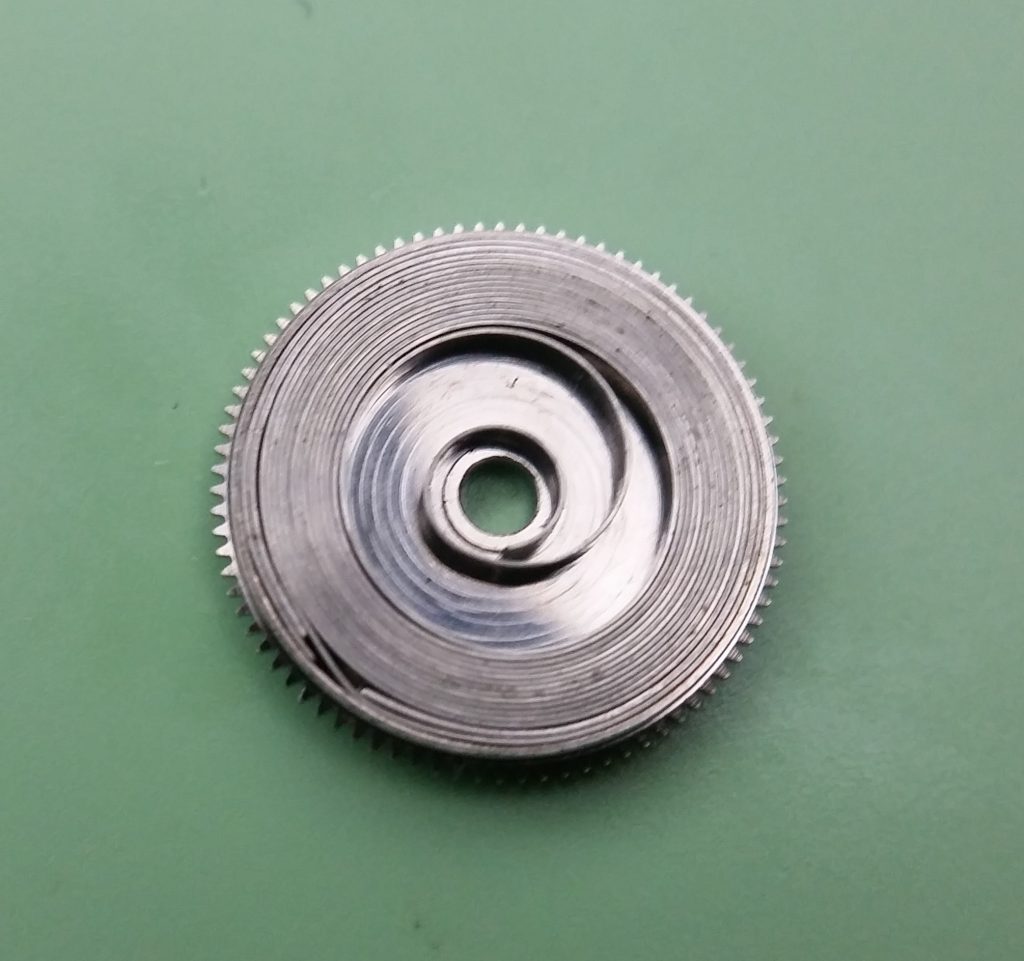
The barrelBarrel Contains the mainspring, and acts as the first wheel in the train.
Barrel - center wheel - third wheel - fourth wheel - escape wheel.
One full rotation every 7 hours or so. is placed in its main plateMain plate The disk upon which all the watch's working parts are mounted. portPort Hole in a plate in which a pivot will sit - usually jeweled. along with the silver-colored escape wheelEscape wheel A curiously shaped wheel whose rotation stops and starts, allowing tiny amounts of power to 'escape' from the mainspring at uniform intervals, thus driving the hands.
Barrel - center wheel - third wheel - fourth wheel - escape wheel.
Generally, the fastest fully rotating wheel in a watch, rotating every 5 seconds or so., then the brass third wheelThird Wheel Third in line of the geared power train:
Barrel - center wheel - third wheel - fourth wheel - escape wheel. top center, and finally the fourth wheelFourth Wheel Fourth in line of the geared power train:
Barrel - center wheel - third wheel - fourth wheel - escape wheel.
Confusingly named - the second hand is usually driven by the fourth wheel.
One full turn every minute. in the very center.
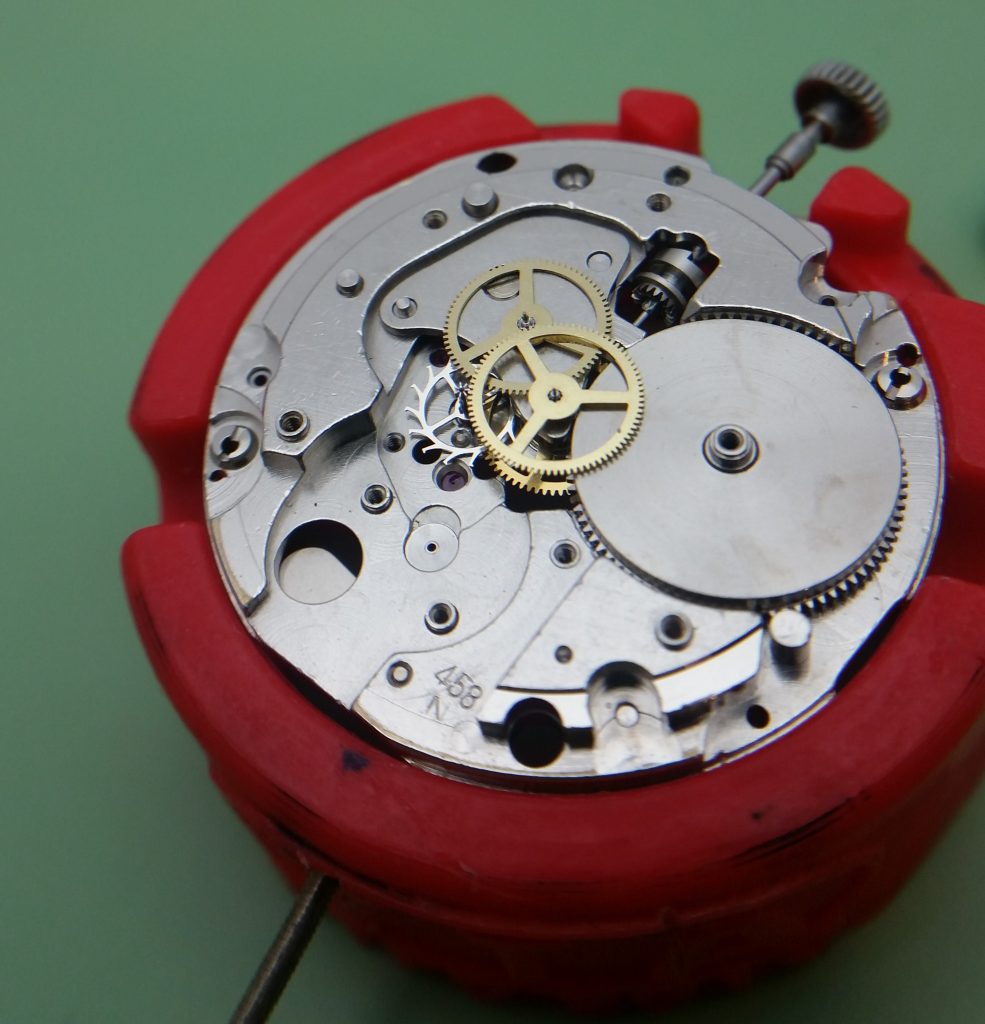
With a little application of (expensive) oil to the tip of the fourth wheelFourth Wheel Fourth in line of the geared power train:
Barrel - center wheel - third wheel - fourth wheel - escape wheel.
Confusingly named - the second hand is usually driven by the fourth wheel.
One full turn every minute. pivotPivot The tip of the staff (axle), usually rests within/upon a jewel., and to the barrelBarrel Contains the mainspring, and acts as the first wheel in the train.
Barrel - center wheel - third wheel - fourth wheel - escape wheel.
One full rotation every 7 hours or so. arborArbor Rotating shaft (axle), usually in reference to the mainspring barrel. (different oil, also expensive), we can gingerly refit the bridgeBridge A flat plate that secures other components in place. Usually screwed down with two or more screws. that holds everything in place. Although a little inelegant visually, the integration of the automatic windingAutomatic winding A mechanical watch that does not need winding, instead deriving it's power from the movement of it's wearer. mechanism (the pincers) into the same trainTrain The sequence of wheels and pinions that transfer motion from the mainspring to the hands.
Barrel - center wheel - third wheel - fourth wheel. bridgeBridge A flat plate that secures other components in place. Usually screwed down with two or more screws. elevates it to an object of design simplicity and efficiency.
Also of note are the two brass diashockDiashock Seiko's shock absorbing spring and jewel system. springs that hold the jewelsJewel Synthetic ruby insert that is used as a bearing. Low friction and resistance to wear. Usually purple. in place, chosen perhaps to add a little shock absorption to the third and escape wheelEscape wheel A curiously shaped wheel whose rotation stops and starts, allowing tiny amounts of power to 'escape' from the mainspring at uniform intervals, thus driving the hands.
Barrel - center wheel - third wheel - fourth wheel - escape wheel.
Generally, the fastest fully rotating wheel in a watch, rotating every 5 seconds or so. pivots, because, as noted earlier, the other ends are mounted in inflexible jewelJewel Synthetic ruby insert that is used as a bearing. Low friction and resistance to wear. Usually purple. caps.
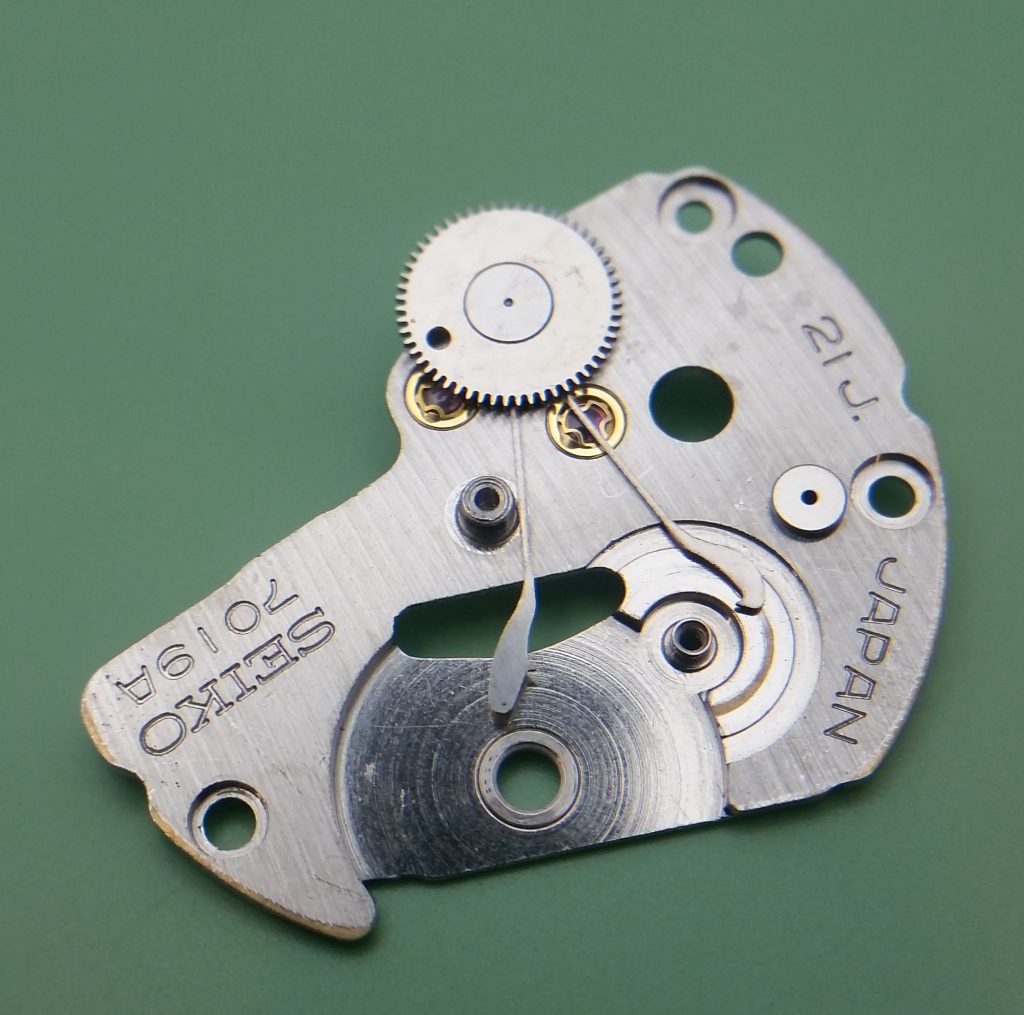
So with the trainTrain The sequence of wheels and pinions that transfer motion from the mainspring to the hands.
Barrel - center wheel - third wheel - fourth wheel. bridgeBridge A flat plate that secures other components in place. Usually screwed down with two or more screws. replaced (carefully – all four trainTrain The sequence of wheels and pinions that transfer motion from the mainspring to the hands.
Barrel - center wheel - third wheel - fourth wheel. wheelsWheel Large cogs. must be aligned before fastening down the screws), its time to fit the palette forkPalette fork Contains two jewels the connect with the escape wheel locking its rotation. It periodically rocks back and forth allowing short bursts of motion., here shown in place, with its bridgeBridge A flat plate that secures other components in place. Usually screwed down with two or more screws. awaiting politely in the wings.

After the fitting of the ratchet wheelratchet wheel Attached to the mainspring barrel, it is incrementally turned by the automatic winding., lubrication of the exit palette stonepalette stone Jewels on the palette fork that interact with the escape wheel. and transfer of said lubricant to the escape wheelEscape wheel A curiously shaped wheel whose rotation stops and starts, allowing tiny amounts of power to 'escape' from the mainspring at uniform intervals, thus driving the hands.
Barrel - center wheel - third wheel - fourth wheel - escape wheel.
Generally, the fastest fully rotating wheel in a watch, rotating every 5 seconds or so. teeth – the details of which I’ll leave to a later post (once this blog has a comments mechanism robust enough to withstand the deluge of opinions that any mention of escapementEscapement The combination of escape wheel and pallet fork, that controls the locking and releasing of the power from the mainspring in precise intervals. lubrication is sure to incite) – all that remains is to replace the balance wheelBalance Wheel A spring driven flywheel that rotates back and forth, acting as a pendulun to regulate the timekeeping. and we’ll hopefully get a heartbeat from our long-dormant patient.
Not so fast! An issue this watch has, which likely contributed to its decades-long purgatory at the bottom of a drawer rather than atop a wrist, is that its hairspringHairspring Spiral spring that rotates back and forth in the balance wheel, controlling the time keeping of the watch.
Not to be confused with the mainspring which stores the power. – which provides the main pulse of the timekeeping – is far from its spiral ideal and has taken on distinctly eccentric profile:
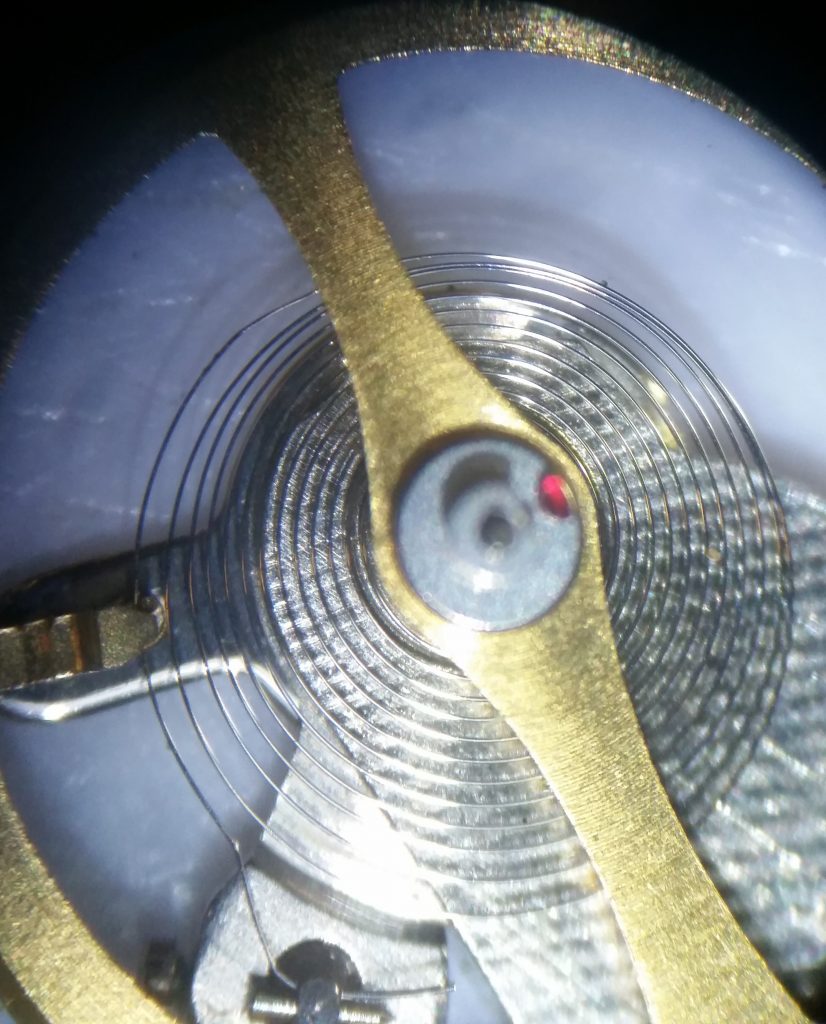
Towards the bottom of the photo the coils are very widely spaced, while towards the top, they are all bunched up to the point of touching – this will result in very poor timekeeping.
The usual reasons for this are one or more of:
Magnetism – these hairspringsHairspring Spiral spring that rotates back and forth in the balance wheel, controlling the time keeping of the watch.
Not to be confused with the mainspring which stores the power. are made from ferrousFerrous Mainly made of iron. alloys that can become magnetized making the coils stick to one another. The rest of the watch, screws aside, is either brass or stainless steel and is thus immune, but until recently the spiral hairspringHairspring Spiral spring that rotates back and forth in the balance wheel, controlling the time keeping of the watch.
Not to be confused with the mainspring which stores the power. (along with the mainspringMainspring A coiled up steel spring that provides the main power source of the watch.) could only be made from steel. This magnetism can strike all too easily in the modern world, but fortunately, the remedy is simple – the whole watch can spend 20 seconds in a demagnetizerDemagnetizer A simple tool used to neutralize any magnetism in a ferrous object. and it’ll be right back to normal. Any jewelry store can do this, or they are available cheaply on ebay.
Oil – stray oil from elsewhere in the watch gets flung onto the hairspringHairspring Spiral spring that rotates back and forth in the balance wheel, controlling the time keeping of the watch.
Not to be confused with the mainspring which stores the power. causing it to stick to itself. This is the inevitable final curtain when someone unskilled in the art tries to oil their watch at home – “I change my car’s oil – how hard can it be really?”
Dirt or rust – if the sealsGasket Rubber seal, usually clamped tight, that prevents moisture and dirt from entering the watch. are no longer water or dustproof, grime and fluids can get in, which will cause havoc everywhere, but if the watch is running really fast then it likely got to the hairspringHairspring Spiral spring that rotates back and forth in the balance wheel, controlling the time keeping of the watch.
Not to be confused with the mainspring which stores the power..
After demagnetizing and cleaning this hairspringHairspring Spiral spring that rotates back and forth in the balance wheel, controlling the time keeping of the watch.
Not to be confused with the mainspring which stores the power., it stubbornly retains its lopsided posture – there’s really no option but to go in and operate.
Open Heart Surgery : technical level 2 (click to skip)
Share this section:
First step is to remove the balance wheelBalance Wheel A spring driven flywheel that rotates back and forth, acting as a pendulun to regulate the timekeeping. from its cockCock A thin plate secured with a single screw., then carefully prise the hairspringHairspring Spiral spring that rotates back and forth in the balance wheel, controlling the time keeping of the watch.
Not to be confused with the mainspring which stores the power. from the balance wheelBalance Wheel A spring driven flywheel that rotates back and forth, acting as a pendulun to regulate the timekeeping. staff (being sure to take note of its orientation). Freed from these constraints the hairspringHairspring Spiral spring that rotates back and forth in the balance wheel, controlling the time keeping of the watch.
Not to be confused with the mainspring which stores the power. opens out into more or less concentric circles, indicating that there is nothing seriously amiss.
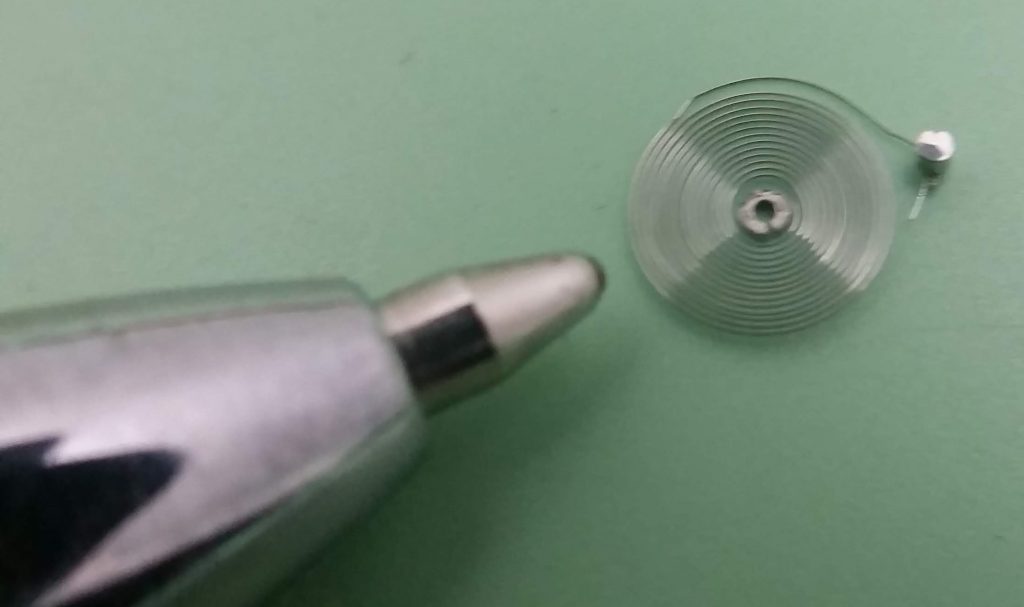
Not to be confused with the mainspring which stores the power., with a ballpoint pen photobomber indicating scale
For this hairspringHairspring Spiral spring that rotates back and forth in the balance wheel, controlling the time keeping of the watch.
Not to be confused with the mainspring which stores the power. to work effectively though, it needs to be re-shaped such that it is correctly positioned at all 3 of its contact points. Let’s attach the bare hairspringHairspring Spiral spring that rotates back and forth in the balance wheel, controlling the time keeping of the watch.
Not to be confused with the mainspring which stores the power. back to the studStud Metal connector at end of hairspring, allowing a connection to the balance cock. of its balance cockBalance Cock Small plate that holds the balance wheel in position. Fixed in place with one screw. and see what needs to be done:

It’s already correct at point 1, the studStud Metal connector at end of hairspring, allowing a connection to the balance cock., and due to the pointed set screw and v-channel design will be reset at this same orientation everytime. So far so good.
The hairspringHairspring Spiral spring that rotates back and forth in the balance wheel, controlling the time keeping of the watch.
Not to be confused with the mainspring which stores the power. will need to be bent inwards so that the inner face of the outermost coil is ‘just not touching’ the regulating pinregulator pins Two pins flanking the outer coil of the hairspring restricting its movement and thus acting as the terminus.
By moving these pins along the hairspring its effective length, and hence its timekeeping is changed. (white dot at 2), which it isn’t by a long way right now. An added complication is that the regulator armRegulator arm Holds the regulating pins over the hairspring, and rotates allowing them to move along the hairspring's length., which 2 is attached to, has to be able to rotate (around the axis 3) about 90 degrees, all while maintaining the ‘just not touching rule’. This is how the timekeeping of the watch is adjusted, and we need to ensure our hairspringHairspring Spiral spring that rotates back and forth in the balance wheel, controlling the time keeping of the watch.
Not to be confused with the mainspring which stores the power. maintains its concentric spiral shape whatever rateRate Overall timekeeping accuracy of the watch - how much faster or slower than the correct time it is running. Usually measured in seconds per day. adjustments we’ll need to make.
Finally, the brass ring at the center has to sit concentrically over point 3.
Let’s switch to the microscope. Using the shaft of a needle (literally – a fine sewing needle), we push the hairspringHairspring Spiral spring that rotates back and forth in the balance wheel, controlling the time keeping of the watch.
Not to be confused with the mainspring which stores the power. at the point of the red arrow – it’s actually more of a stroking action along the spring length while exerting pressure in that general direction. The spring is, as its name suggests, springy, so we have to push it quite a bit further than needed in order to have it bounce back most of the way, while leaving a little permanent deformation so that it ‘just doesn’t touch’ the white dot. With experience – mostly bitter – one gets to sense the faint pushback the spring exerts on the needle. Little by little is the mantra here.
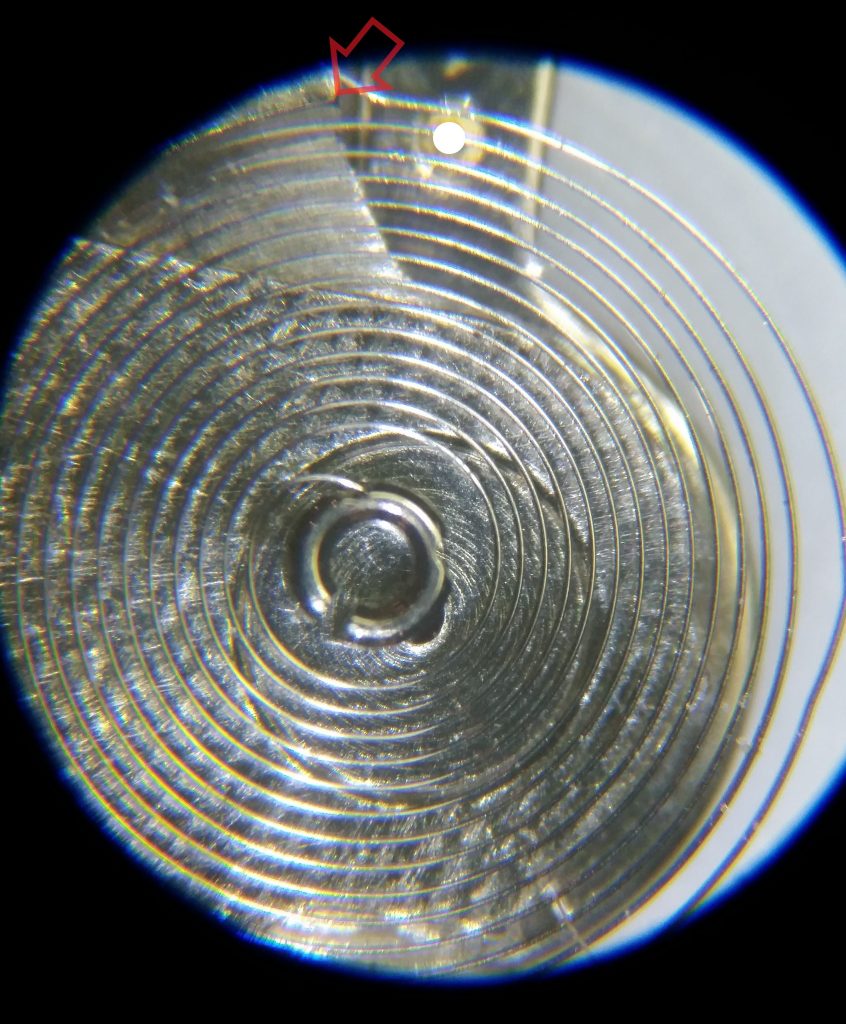
Not to be confused with the mainspring which stores the power. is loaded in the studStud Metal connector at end of hairspring, allowing a connection to the balance cock. at a higher elevation than when it’s mounted for real,
hence it won’t connect with the regulator pin, merely hovering above it.
Once that is dialed in, we can move the regulator index to the 45 degree mid-point, and holding the spring steady at the previously set positionPosition Usually refers to a specific orientation of the watch. Timekeeping is optimized in multiple positions (usually up to 6) in the hope that during everyday wear the watch will keep some average of all measurements. (in blue) with the finest tweezers they make, again push down along the red arrow with the needle.
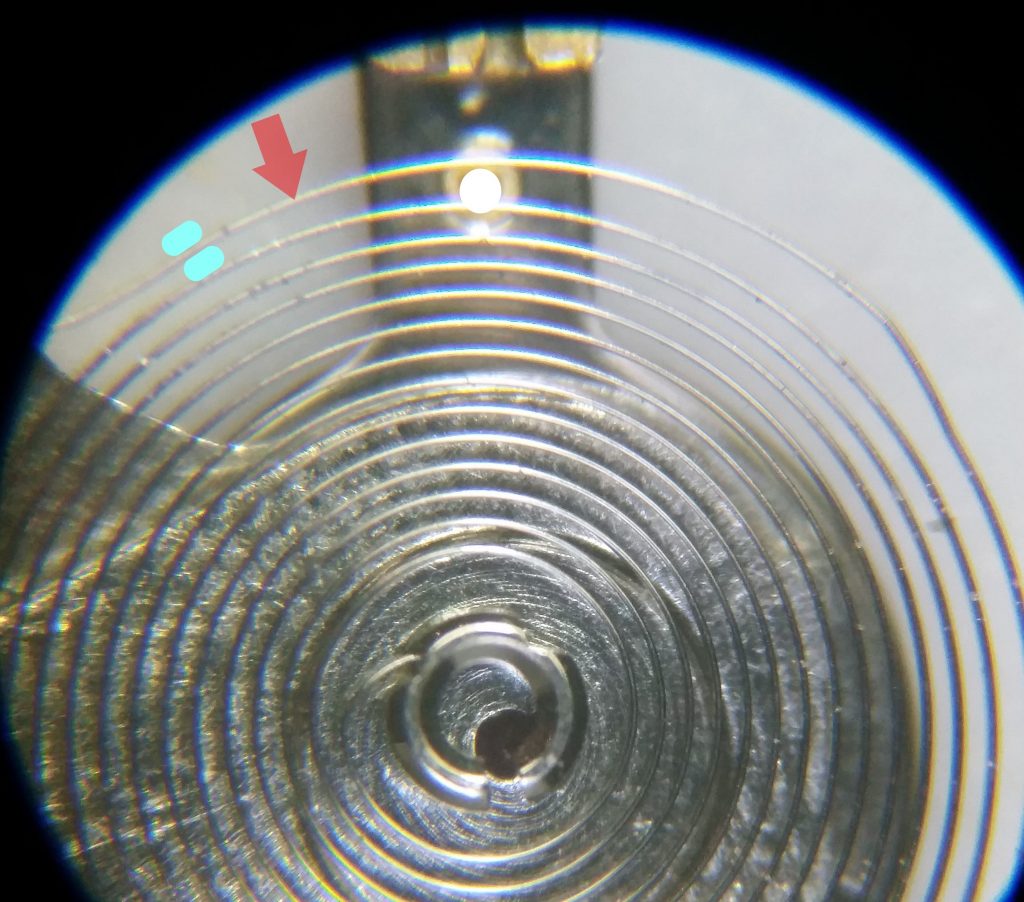
And once again with the regulator at the 90 degree extreme:
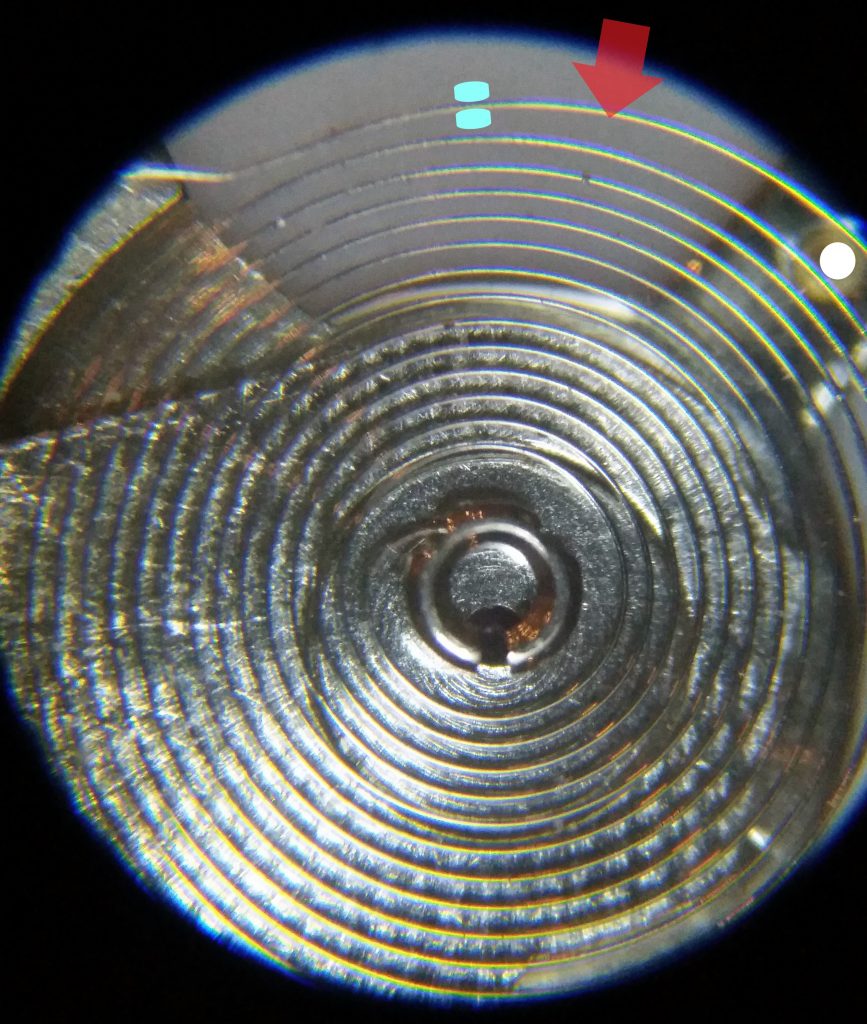
All that remains now is to coerce the quarreling centers back into peaceful co-axial relations, achieved by an artful combination of tweaking the spring’s angle alternately at the two elbows below:
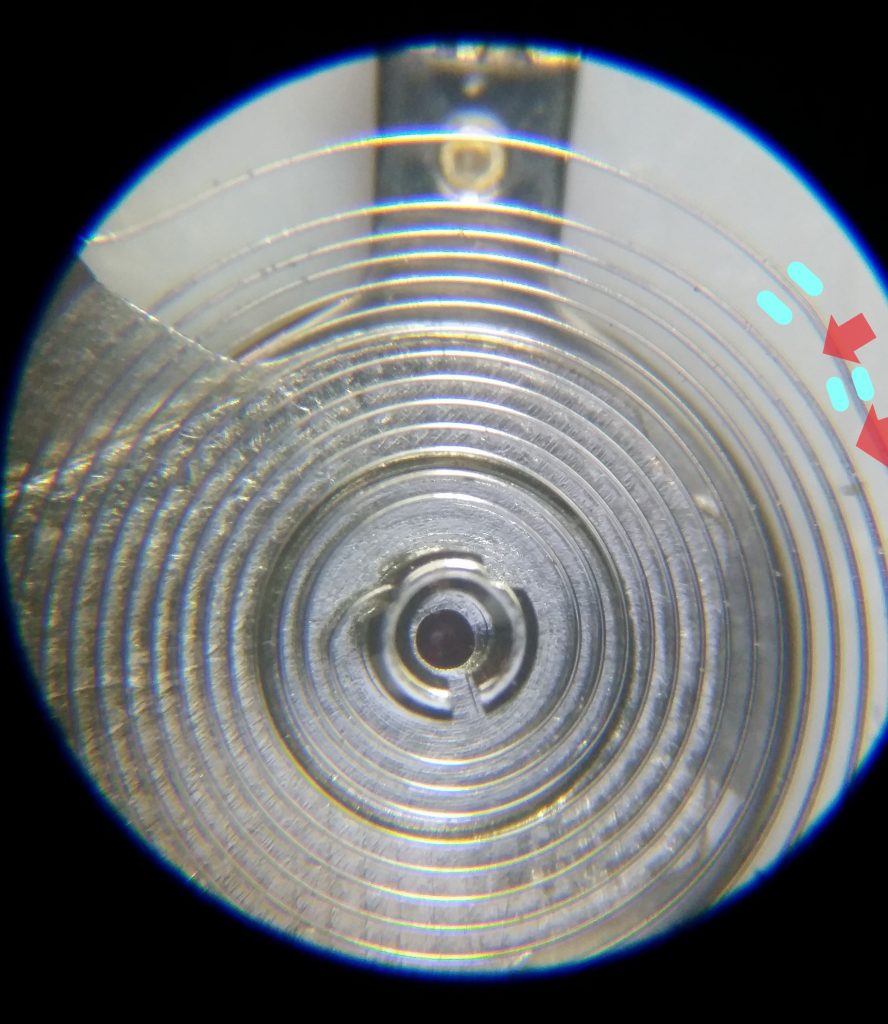
A quick check from a side-on angle that the hairspringHairspring Spiral spring that rotates back and forth in the balance wheel, controlling the time keeping of the watch.
Not to be confused with the mainspring which stores the power. is still planar and parallel and we’re good to go.
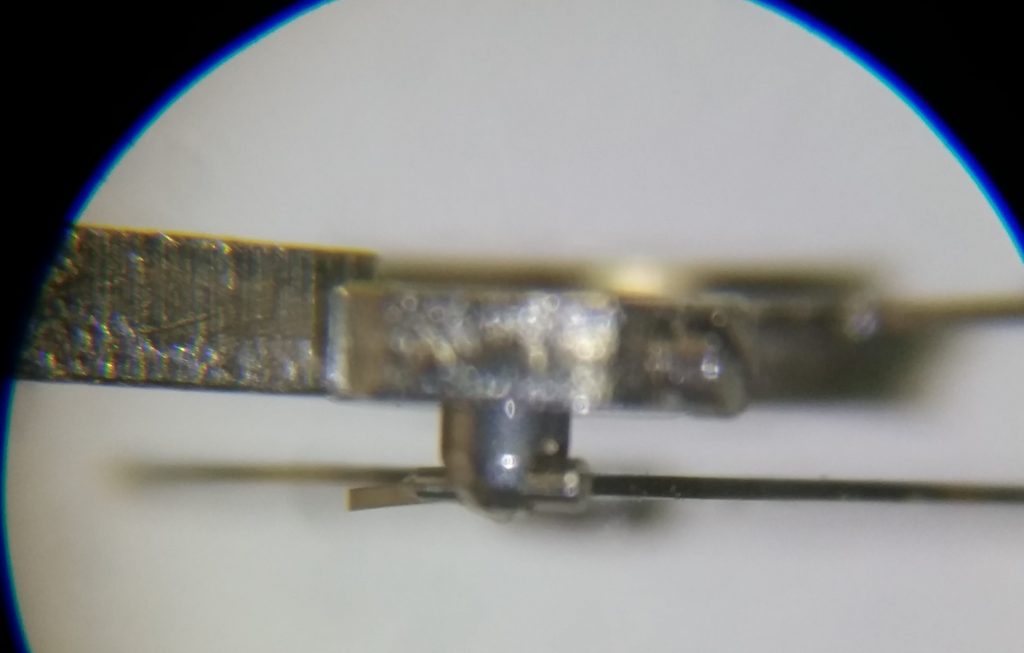
Not to be confused with the mainspring which stores the power. manipulation exercise.
Because the hairspringHairspring Spiral spring that rotates back and forth in the balance wheel, controlling the time keeping of the watch.
Not to be confused with the mainspring which stores the power. is in the correct shape at the 3 critical points it can now be pressed back onto its balance wheelBalance Wheel A spring driven flywheel that rotates back and forth, acting as a pendulun to regulate the timekeeping. (recalling it’s previous orientation), the studStud Metal connector at end of hairspring, allowing a connection to the balance cock. re-attached to the cockCock A thin plate secured with a single screw., and the regulator pinsregulator pins Two pins flanking the outer coil of the hairspring restricting its movement and thus acting as the terminus.
By moving these pins along the hairspring its effective length, and hence its timekeeping is changed. clamped around the hairspringHairspring Spiral spring that rotates back and forth in the balance wheel, controlling the time keeping of the watch.
Not to be confused with the mainspring which stores the power., without becoming distorted, eccentric, or touching. We are good to go!
Mounting the resurrected balance wheelBalance Wheel A spring driven flywheel that rotates back and forth, acting as a pendulun to regulate the timekeeping. back onto the movementMovement A noun, referring to the whole of the inner workings of a watch. Not a great choice of word, in my opinion.….
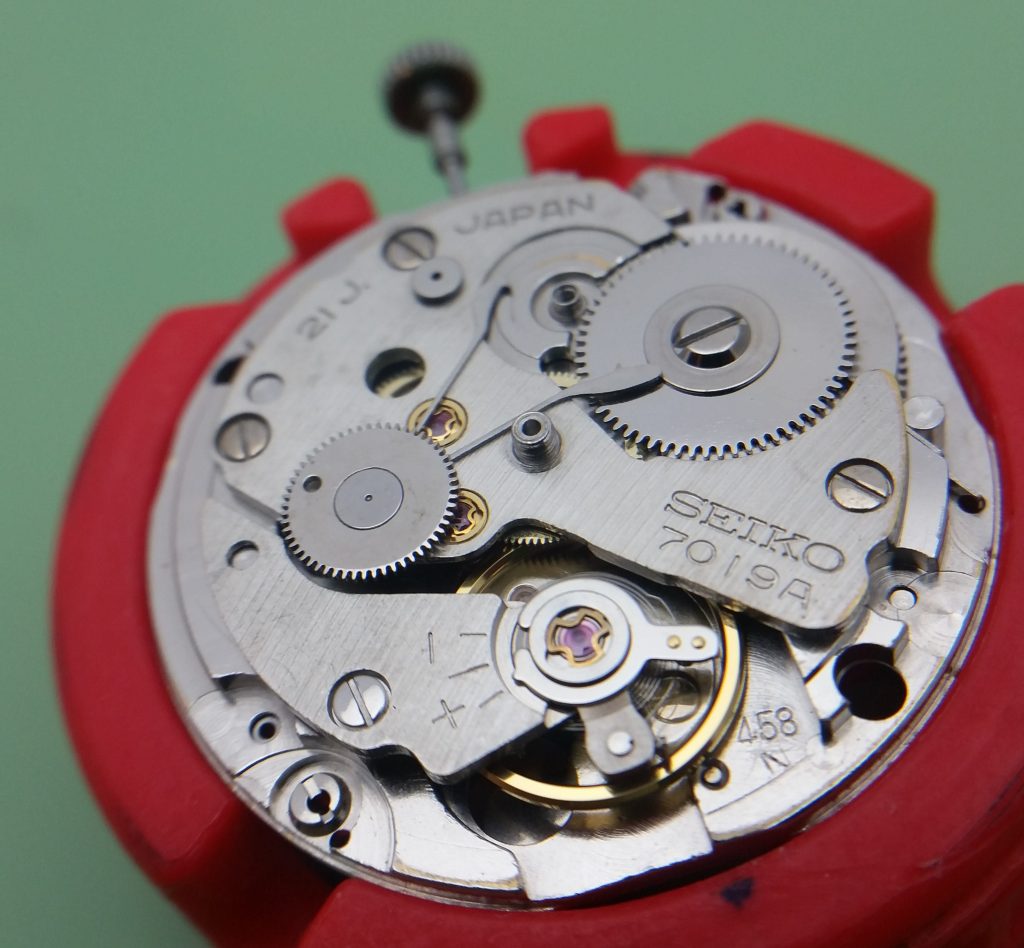
…and the heart is beating for the first time in decades. The patient is allowed to enjoy it’s convalescence overnight, giving those expensive oils time to diffuse deep into its aching joints.
At doctors rounds the next morning, after various pokings and proddings, the patient is showing healthy vitals on the ECG – pulse averaging +3 seconds per day, blood pressure at a steady 270 over 235, and arrhythmia under 0.5ms, but what caught my eye was the variation of rates across the vertical positionsvertical positions When the watch is upright.. Unlike its quartzQuartz A watch that derives its timekeeping from the electrical vibrations of quartz crystal. Accurate and cheap. contemporaries, a mechanical watch is susceptible to changes in its timekeeping depending on the angle at which it is held, an ailment we will now endeavor to minimize.
Dynamic PoisingPoise To be uniformly balanced and even. : technical level 2 (click to skip)
Share this section:
Clearly, the angle of the watch changes as the wearer’s wrist goes through its daily motions, but in a clinical setting these changes are usually sampled at 6 key positionsPosition Usually refers to a specific orientation of the watch. Timekeeping is optimized in multiple positions (usually up to 6) in the hope that during everyday wear the watch will keep some average of all measurements.:
Two horizontal positionshorizontal positions When the watch is dial up (DU) or dial down (DD).:
DU – dialDial The visible face of the watch. up, as when the watch is resting on a table.
DD – dialDial The visible face of the watch. down, as when it is turned over, resting on its crystalCrystal The clear glass on the front of a watch..
Four vertical positionsvertical positions When the watch is upright.:
3Up – as when the wearer is pointing up into the air, aka CrownCrown Small, decorative, external control used by the wearer to set time and calendars.
Usually at 3 o'clock. Up – CU
6Up – as when the wearer is grasping a mug of coffee, aka CrownCrown Small, decorative, external control used by the wearer to set time and calendars.
Usually at 3 o'clock. Left – CL
9Up – as when the wearer’s arm is down by their side, aka CrownCrown Small, decorative, external control used by the wearer to set time and calendars.
Usually at 3 o'clock. Cown – CD
12Up – as when the wearer is looking at the watch in front of their face, aka CrownCrown Small, decorative, external control used by the wearer to set time and calendars.
Usually at 3 o'clock. Right – CR.
I prefer the use of the NumberUp nomenclature, rather than the positionPosition Usually refers to a specific orientation of the watch. Timekeeping is optimized in multiple positions (usually up to 6) in the hope that during everyday wear the watch will keep some average of all measurements. of the crownCrown Small, decorative, external control used by the wearer to set time and calendars.
Usually at 3 o'clock., as it allows for easy naming of in-between positionsPosition Usually refers to a specific orientation of the watch. Timekeeping is optimized in multiple positions (usually up to 6) in the hope that during everyday wear the watch will keep some average of all measurements., and avoids the issue that crownCrown Small, decorative, external control used by the wearer to set time and calendars.
Usually at 3 o'clock. left and crownCrown Small, decorative, external control used by the wearer to set time and calendars.
Usually at 3 o'clock. right depends on which side of the movementMovement A noun, referring to the whole of the inner workings of a watch. Not a great choice of word, in my opinion. we are viewing from.
Looking at the timegrapherTimegrapher Electronic device that listens to the ticking of a watch to determine if it's running well. results, it is the vertical positionsvertical positions When the watch is upright. which are troubling in this watch as, when fully wound, the gold line on the graph below shows changes in timekeeping, (known as “deltaDelta Change or difference, usually referring to the extremes of timekeeping of a watch, measured in seconds per day.”), that are a full 25 seconds between the fastest and slowest rates. I’ve included some extra in-between data readings as well to make the curves smoother. The green line is ‘perfect time’ – that’s what we’re aiming for (without buying a quartzQuartz A watch that derives its timekeeping from the electrical vibrations of quartz crystal. Accurate and cheap. watch of course).
Also shown in dark green are the results with a very low mainspringMainspring A coiled up steel spring that provides the main power source of the watch. windingWinding How wound up the mainspring is. – the watch is an hour or so away from stopping altogether at this point. AmplitudesAmplitude A measure of how far the balance wheel is rotating each swing.
Analogous to how wide a pendulum is swinging.
Measured in degrees, with higher being better (up to around 330 degrees) in these 2 vertical positionsvertical positions When the watch is upright. are averaging 235 degrees, (Seikos are designed to work at lower amplitudesAmplitude A measure of how far the balance wheel is rotating each swing.
Analogous to how wide a pendulum is swinging.
Measured in degrees, with higher being better (up to around 330 degrees)), and 130 (anything much below this and the readings get noisy).

The dark green line is on average a lot slower, as we might expect, but also shows a lot more variation between fastest and slowest – 201 seconds. More surprisingly, it is now slowest around the 5 positionPosition Usually refers to a specific orientation of the watch. Timekeeping is optimized in multiple positions (usually up to 6) in the hope that during everyday wear the watch will keep some average of all measurements., where previously it was fastest, while 180 degrees later, around the 10 positionPosition Usually refers to a specific orientation of the watch. Timekeeping is optimized in multiple positions (usually up to 6) in the hope that during everyday wear the watch will keep some average of all measurements., it is now fastest where it was slowest. The timing has been turned on its head!
After some trial and error, I home in the amount of mainspringMainspring A coiled up steel spring that provides the main power source of the watch. windWinding How wound up the mainspring is., somewhere between the two previous settings, that flips the curves from one to the other, and it is just here, balanced on a horologicalHorology The study of timekeeping. knife edge that the watch keeps reasonable time – less than 10 seconds variation along the orange line.

Analogous to how wide a pendulum is swinging.
Measured in degrees, with higher being better (up to around 330 degrees) averaging 211.
The prospect of monitoring my arm movementMovement A noun, referring to the whole of the inner workings of a watch. Not a great choice of word, in my opinion. so as to windWinding How wound up the mainspring is. the automatic watchAutomatic winding A mechanical watch that does not need winding, instead deriving it's power from the movement of it's wearer. no more nor less than this perfect windingWinding How wound up the mainspring is. is no more practical than keeping my wrist at some optimal angle in the first place, so we are going to have to address the issue that is causing these wild swings in rateRate Overall timekeeping accuracy of the watch - how much faster or slower than the correct time it is running. Usually measured in seconds per day. in order that the watch runs optimally at most usual levels of windWinding How wound up the mainspring is. and most usual positionsPosition Usually refers to a specific orientation of the watch. Timekeeping is optimized in multiple positions (usually up to 6) in the hope that during everyday wear the watch will keep some average of all measurements..
And my diagnosis is that it’s a poisePoise To be uniformly balanced and even. error – that is, the hairspringHairspring Spiral spring that rotates back and forth in the balance wheel, controlling the time keeping of the watch.
Not to be confused with the mainspring which stores the power. and balance wheelBalance Wheel A spring driven flywheel that rotates back and forth, acting as a pendulun to regulate the timekeeping. is not, if you’ll pardon the phrase, in balance. Switching shamelessly to an automobile analogy for a moment, it’s the same issue that is addressed by adding weights to the rim of a car’s wheelWheel Large cogs..
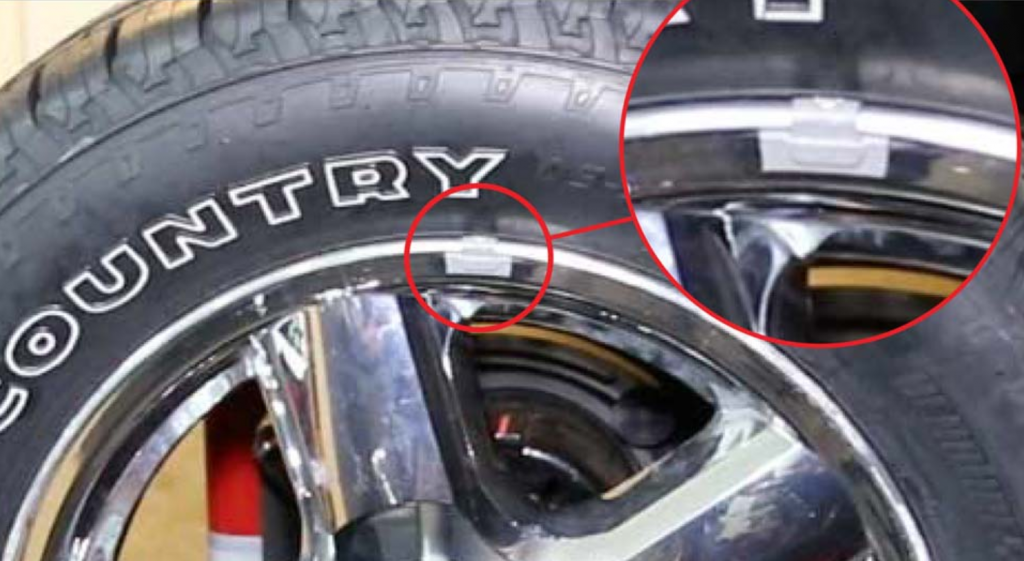
In a watch’s case, the tire is the rim of the balance wheelBalance Wheel A spring driven flywheel that rotates back and forth, acting as a pendulun to regulate the timekeeping., but adding weight is no longer an option on modern smooth balancesBalance Wheel A spring driven flywheel that rotates back and forth, acting as a pendulun to regulate the timekeeping., so we’ll have to remove weight on the opposite side instead – an action that is irreversible. The underside of the balance wheelBalance Wheel A spring driven flywheel that rotates back and forth, acting as a pendulun to regulate the timekeeping. already shows the factory poisePoise To be uniformly balanced and even. work – the neat scar at 4 o’clock machined nearly half a century prior – but this was likely done by static poisingPoise To be uniformly balanced and even., which can only go so far in correcting the errors when the balance wheelBalance Wheel A spring driven flywheel that rotates back and forth, acting as a pendulun to regulate the timekeeping. is in motion. By undertaking dynamic poisingPoise To be uniformly balanced and even., we aim to correct for the combined weight imbalance of the balance wheelBalance Wheel A spring driven flywheel that rotates back and forth, acting as a pendulun to regulate the timekeeping., the hairspringHairspring Spiral spring that rotates back and forth in the balance wheel, controlling the time keeping of the watch.
Not to be confused with the mainspring which stores the power. (even as it winds up and down in motion), and the colletCollet Soft brass ring that friction fits onto a staff (axle), i.e. at the center terminal of a hairspring. that holds the two together.
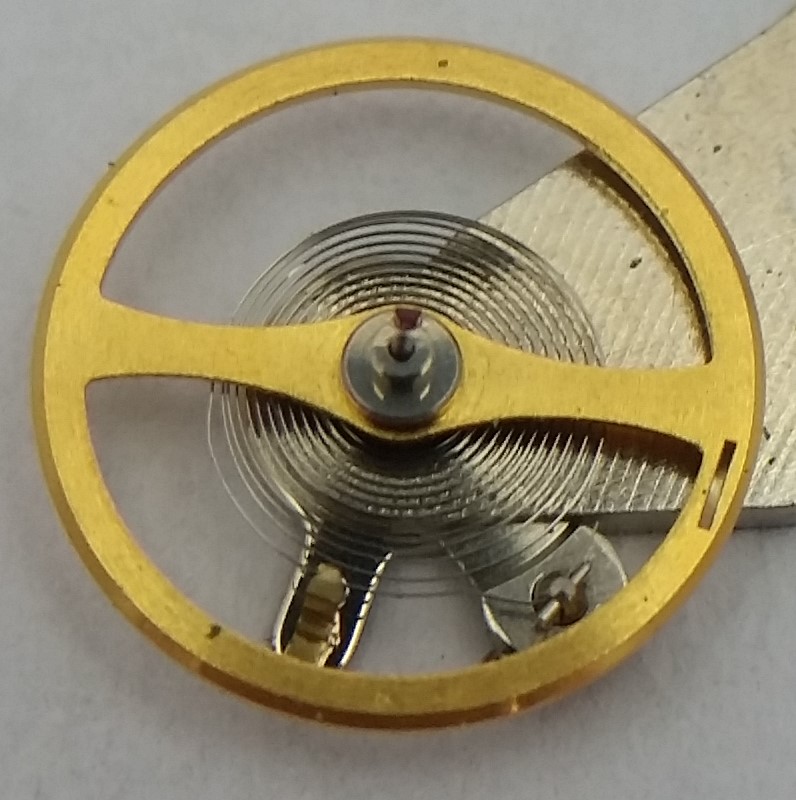
(Sorry, this photo was taken before the hairspringHairspring Spiral spring that rotates back and forth in the balance wheel, controlling the time keeping of the watch.
Not to be confused with the mainspring which stores the power. adjustments)
While a car wheelWheel Large cogs. exhibits its poor wheelWheel Large cogs. balancing with an unnerving vibration felt when driving at a certain speed, a watch’s balance wheelBalance Wheel A spring driven flywheel that rotates back and forth, acting as a pendulun to regulate the timekeeping. reveals it’s poor poisePoise To be uniformly balanced and even. by changes in rateRate Overall timekeeping accuracy of the watch - how much faster or slower than the correct time it is running. Usually measured in seconds per day. depending on vertical positionvertical positions When the watch is upright. – particularly noticeable at low amplitudeAmplitude A measure of how far the balance wheel is rotating each swing.
Analogous to how wide a pendulum is swinging.
Measured in degrees, with higher being better (up to around 330 degrees). At low amplitudesAmplitude A measure of how far the balance wheel is rotating each swing.
Analogous to how wide a pendulum is swinging.
Measured in degrees, with higher being better (up to around 330 degrees) the rateRate Overall timekeeping accuracy of the watch - how much faster or slower than the correct time it is running. Usually measured in seconds per day. is slowest when the watch is orientated such that the heavy spot on the balance wheelBalance Wheel A spring driven flywheel that rotates back and forth, acting as a pendulun to regulate the timekeeping. is directly above the balance staffBalance staff The axel of the balance wheel. (axle). At high amplitudesAmplitude A measure of how far the balance wheel is rotating each swing.
Analogous to how wide a pendulum is swinging.
Measured in degrees, with higher being better (up to around 330 degrees) meanwhile, poor poisePoise To be uniformly balanced and even. will produce the fastest rateRate Overall timekeeping accuracy of the watch - how much faster or slower than the correct time it is running. Usually measured in seconds per day. when the heavy spot is directly above the balance staffBalance staff The axel of the balance wheel.. And at middling amplitudesAmplitude A measure of how far the balance wheel is rotating each swing.
Analogous to how wide a pendulum is swinging.
Measured in degrees, with higher being better (up to around 330 degrees) (theoretically at 220 degrees), there should be no rateRate Overall timekeeping accuracy of the watch - how much faster or slower than the correct time it is running. Usually measured in seconds per day. bias in any positionPosition Usually refers to a specific orientation of the watch. Timekeeping is optimized in multiple positions (usually up to 6) in the hope that during everyday wear the watch will keep some average of all measurements. from poor poisePoise To be uniformly balanced and even..
This can all get a bit confusing, so I created a poisingPoise To be uniformly balanced and even. chart (only valid for SeikoSeiko A Japanese manufacturer of watches. 70** series movementsMovement A noun, referring to the whole of the inner workings of a watch. Not a great choice of word, in my opinion.) that allow a quick conversion from the low amplitudeAmplitude A measure of how far the balance wheel is rotating each swing.
Analogous to how wide a pendulum is swinging.
Measured in degrees, with higher being better (up to around 330 degrees) (dark green line above) graph’s slowest reading (around 5 in this case) to the point on the circumference of the balance wheelBalance Wheel A spring driven flywheel that rotates back and forth, acting as a pendulun to regulate the timekeeping. where weight needs to be removed:
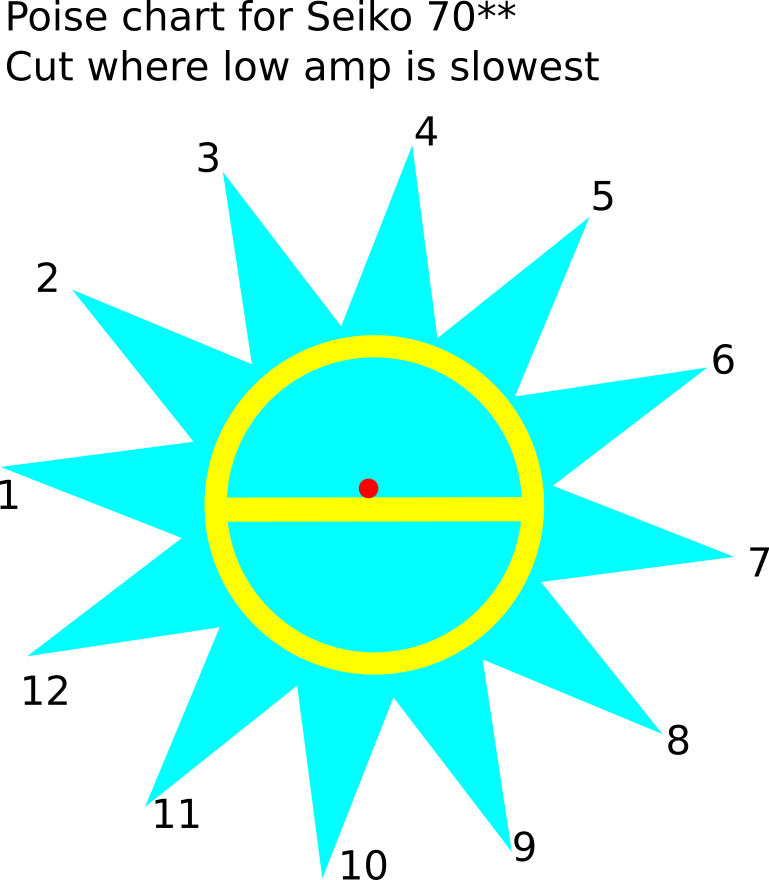
Most other jewels are arranged in pairs - this lone jewel is the reason that most movements have an odd jewel count. on the yellow balance wheelBalance Wheel A spring driven flywheel that rotates back and forth, acting as a pendulun to regulate the timekeeping..
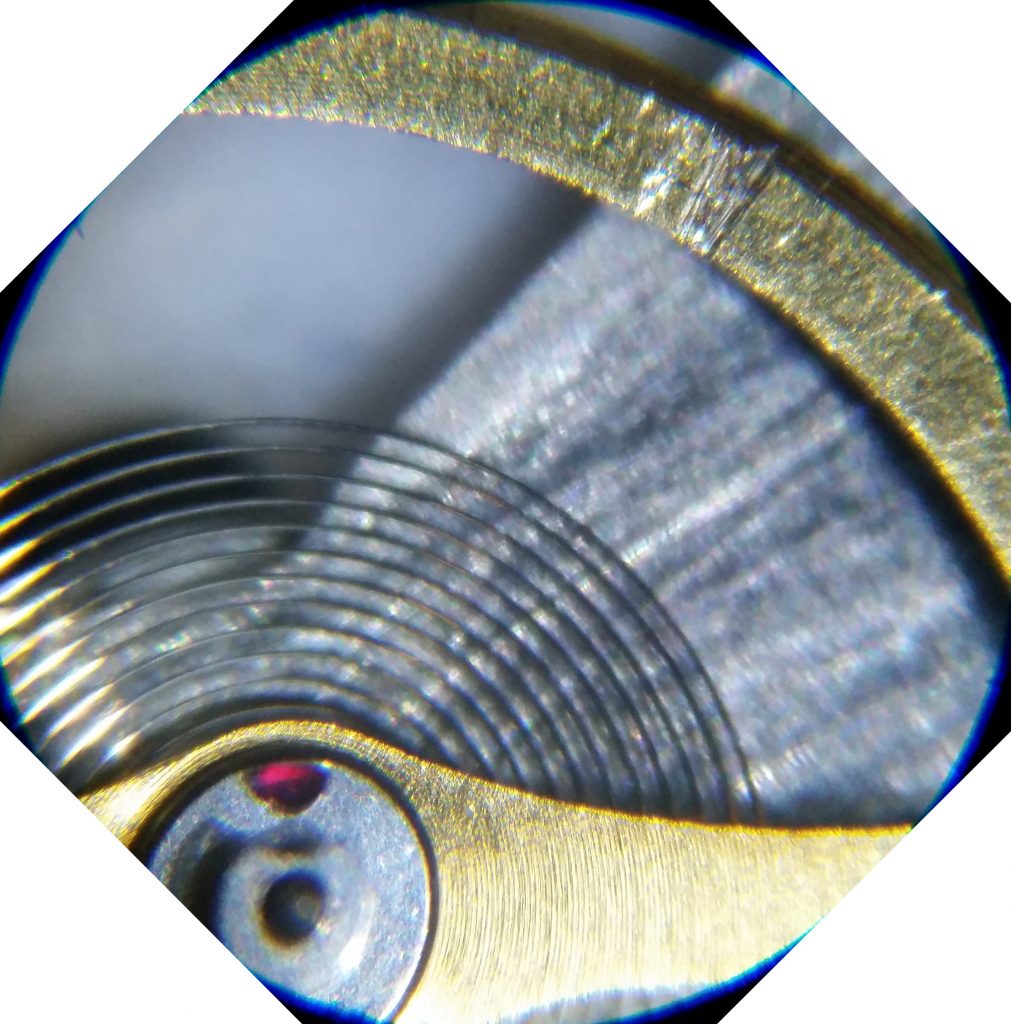
And another round of measurements on the timegrapherTimegrapher Electronic device that listens to the ticking of a watch to determine if it's running well.:

The newly added brown line shows a distinct improvement as the trough is less deep and the peak less high. Too little is better than too much, so let go in for another round, noting that the low spot has now shifted to 4.
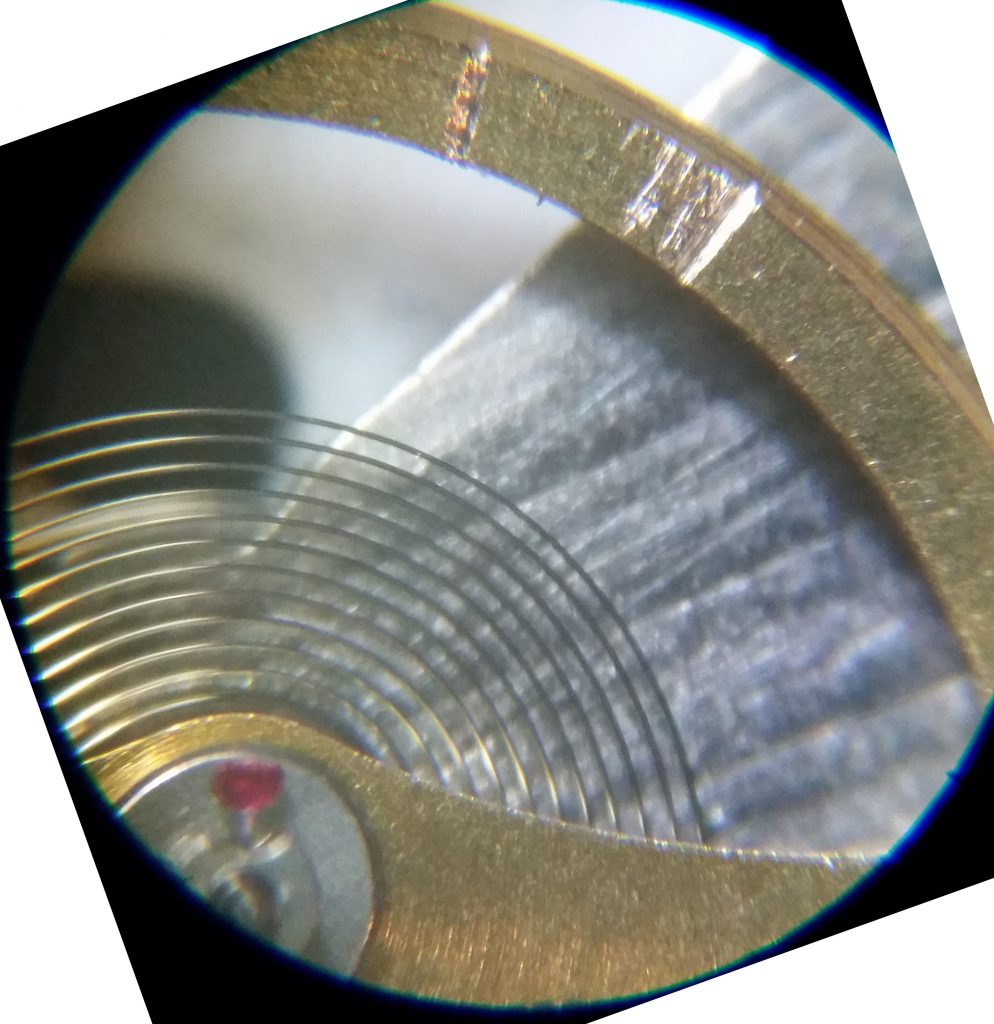
Back on the timegrapherTimegrapher Electronic device that listens to the ticking of a watch to determine if it's running well., reveals a further improvement with the pink line:
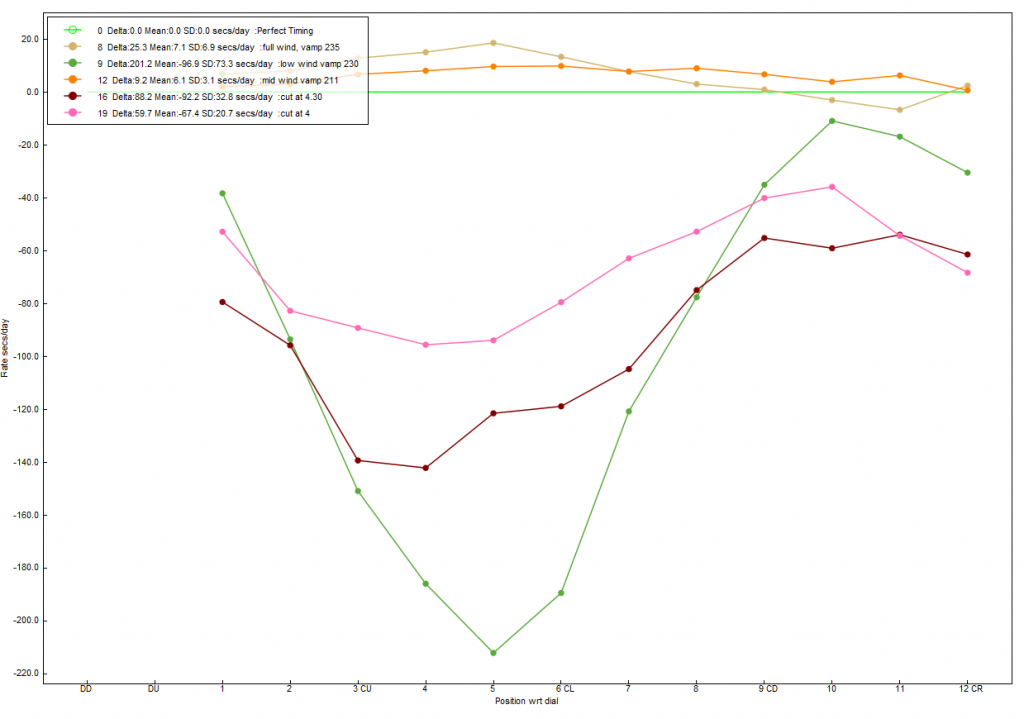
Just a little more filing at 4 and I think our work here is done, the new line (black) is still wavy, but it no longer looks like a poisePoise To be uniformly balanced and even. issue, as it’s contours match (rather than mirror) those of the new full windWinding How wound up the mainspring is. line (purple), which is showing a reduction in its deltaDelta Change or difference, usually referring to the extremes of timekeeping of a watch, measured in seconds per day. of 10 seconds. Phew!

PoisingPoise To be uniformly balanced and even. Theory : technical level 3 (click to skip)
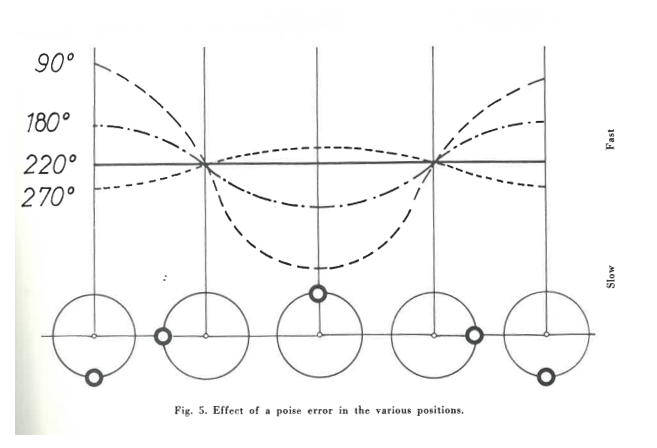
This is a chart from Hans Jendritzki’s Watch Adjustment showing the theoretical curves of the same poisingPoise To be uniformly balanced and even. rateRate Overall timekeeping accuracy of the watch - how much faster or slower than the correct time it is running. Usually measured in seconds per day. changes vs positionPosition Usually refers to a specific orientation of the watch. Timekeeping is optimized in multiple positions (usually up to 6) in the hope that during everyday wear the watch will keep some average of all measurements., at various amplitudesAmplitude A measure of how far the balance wheel is rotating each swing.
Analogous to how wide a pendulum is swinging.
Measured in degrees, with higher being better (up to around 330 degrees). The theoretical amplitudeAmplitude A measure of how far the balance wheel is rotating each swing.
Analogous to how wide a pendulum is swinging.
Measured in degrees, with higher being better (up to around 330 degrees) of inversion is 220 degrees, rather than 211, which was the closest I could get. My graphs show real-life data, noise and all, with lines showing rates at constant power not the constant amplitudeAmplitude A measure of how far the balance wheel is rotating each swing.
Analogous to how wide a pendulum is swinging.
Measured in degrees, with higher being better (up to around 330 degrees) of Jendritzki’s graph. Here are the corresponding amplitudesAmplitude A measure of how far the balance wheel is rotating each swing.
Analogous to how wide a pendulum is swinging.
Measured in degrees, with higher being better (up to around 330 degrees) for the previously presented data, prior to poiseing:

The only way to get lines of constant amplitudeAmplitude A measure of how far the balance wheel is rotating each swing.
Analogous to how wide a pendulum is swinging.
Measured in degrees, with higher being better (up to around 330 degrees) would be to take multiple readings over the course of the mainspringMainspring A coiled up steel spring that provides the main power source of the watch. naturally windingWinding How wound up the mainspring is. down, and then, for each positionPosition Usually refers to a specific orientation of the watch. Timekeeping is optimized in multiple positions (usually up to 6) in the hope that during everyday wear the watch will keep some average of all measurements., select the datum at the correct amplitudeAmplitude A measure of how far the balance wheel is rotating each swing.
Analogous to how wide a pendulum is swinging.
Measured in degrees, with higher being better (up to around 330 degrees).
Even I don’t have sufficient time on my hands for such an undertaking right now – but watch this space!
I should add that many other hairspringHairspring Spiral spring that rotates back and forth in the balance wheel, controlling the time keeping of the watch.
Not to be confused with the mainspring which stores the power. & balance issues will cause this characteristic sine waveSinusoidal of a pure wave. variation in timings, but only poor poisePoise To be uniformly balanced and even. exhibits the characteristic flip in phase around the 220 degrees mark. Also, other prior adjustments needed to be made on this movementMovement A noun, referring to the whole of the inner workings of a watch. Not a great choice of word, in my opinion. to produce timings clean enough to reliably detect its poor poisePoise To be uniformly balanced and even.. Techniques for dealing with other issues will be covered in posts of future watch restorations – fear not, I’ve quite a backlog!
So with the movementMovement A noun, referring to the whole of the inner workings of a watch. Not a great choice of word, in my opinion. ticking and healthy, we can turn over once more to rebuild the remaining calendar sideCalendar side The side of the movement that contains the day and date, and occasionally, month, year and phase of the moon, workings.
It is the side adjacent to the dial.:
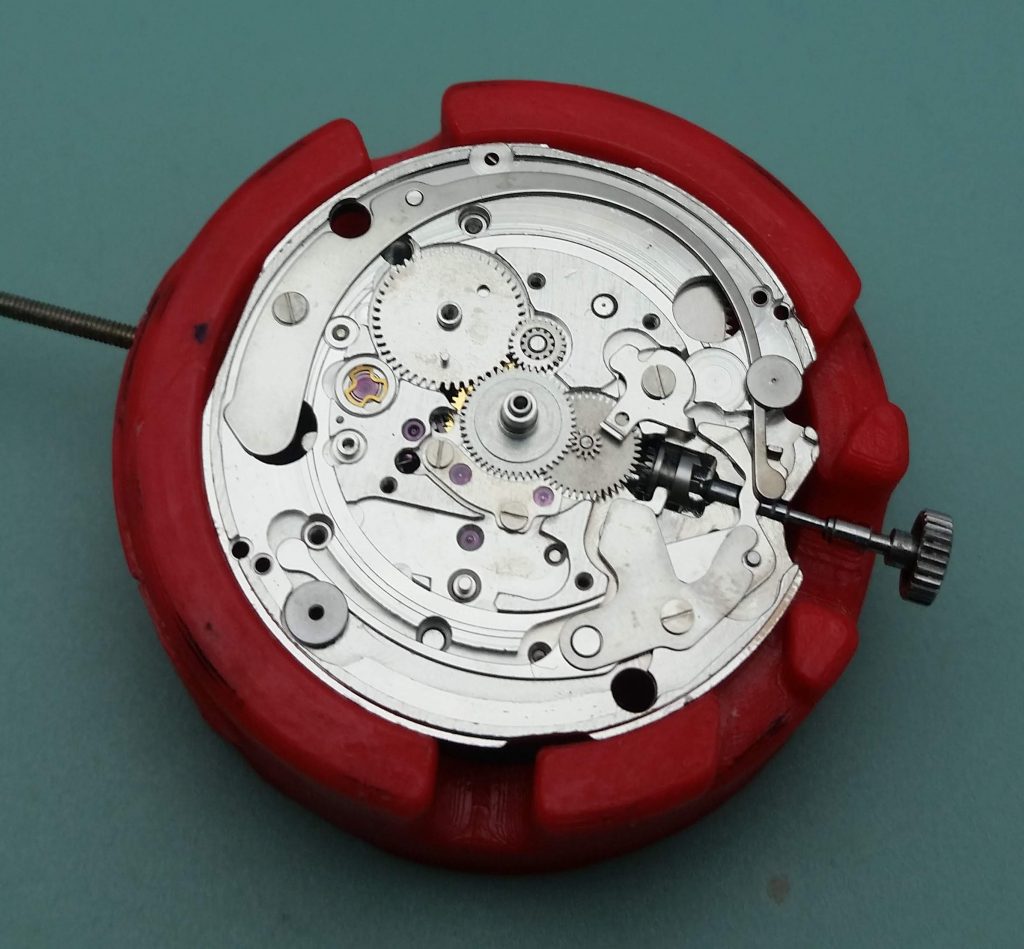
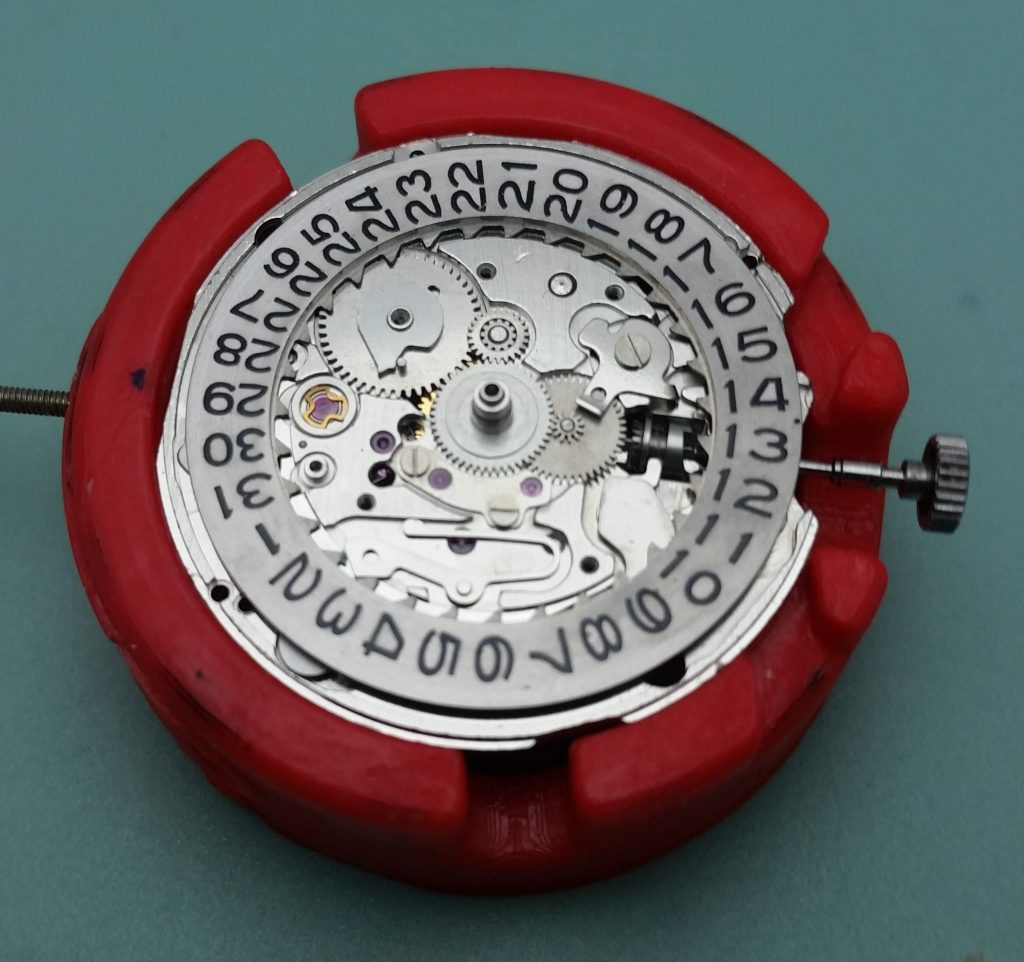
and its jumperJumper A spring used to constrain a cogs rotation. (bottom by the ‘3rd’), that snaps it into the next positionPosition Usually refers to a specific orientation of the watch. Timekeeping is optimized in multiple positions (usually up to 6) in the hope that during everyday wear the watch will keep some average of all measurements., keeping it aligned in the dialDial The visible face of the watch. window.
At this point in production, SeikoSeiko A Japanese manufacturer of watches. was still using all metal parts for the calendar wheelsWheel Large cogs. and fingers. They soon moved on to those new fangled plastics, which, while running smoothly without lubricants, (and lowering costs), broke with centuries of horologicalHorology The study of timekeeping. tradition, and, to my mind, just don’t provide that same sense of pride upon successful restoration.
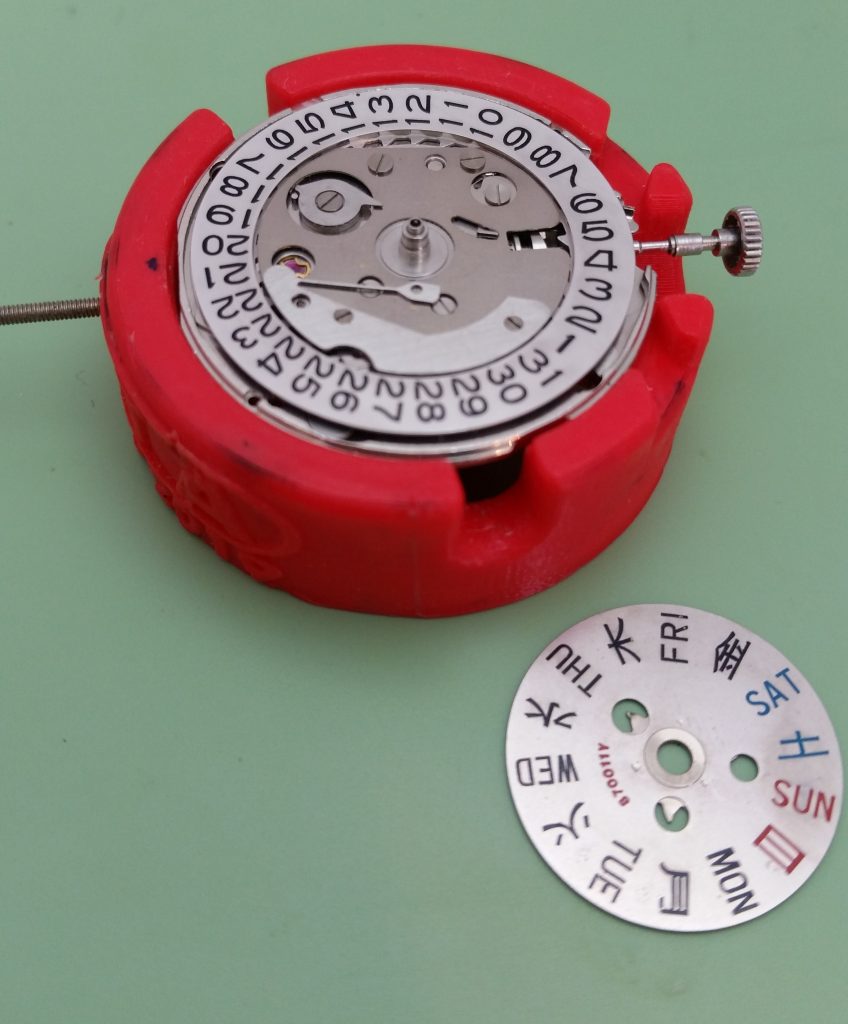
(a snap clip, not pictured, then goes atop the day-diskDay wheel A rotating disk, printed with the days of the week, one of which is visible thru a window on the dial.)
For the same reason that SeikoSeiko A Japanese manufacturer of watches. even included an English option for days on this Japanese domestic market watch, I choose to use the kanjiKanji The adopted logographic Chinese characters that are used in the Japanese writing system. option despite my mastery of the language progressing no further than a passable ‘hello’.
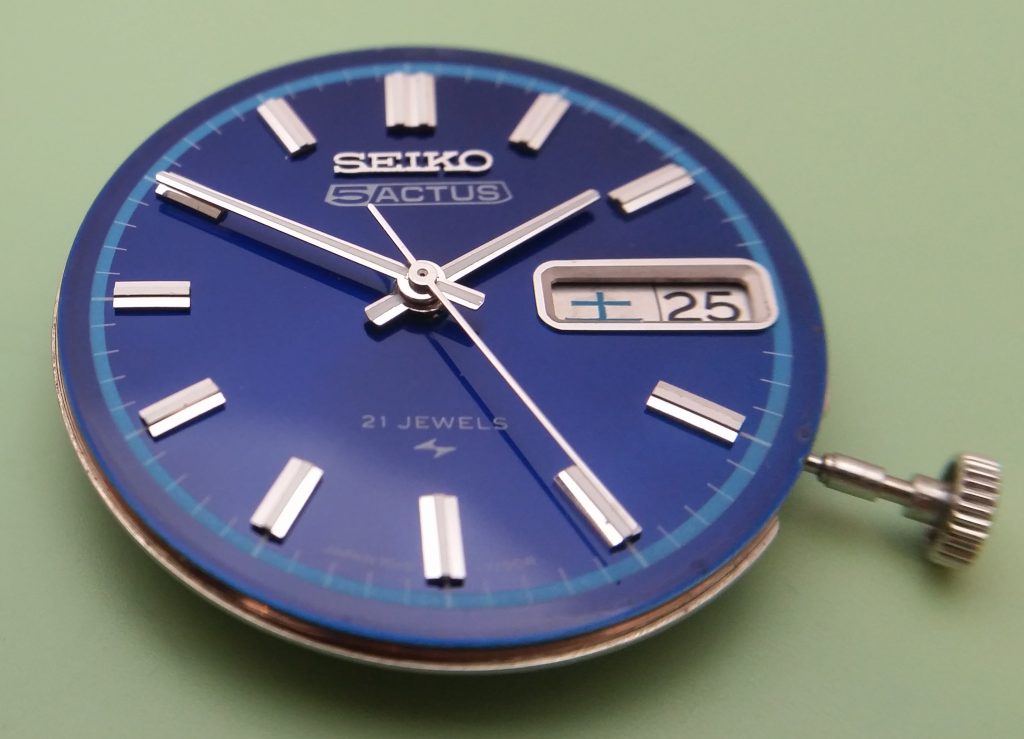
With the inner workings of the watch all but rebuilt, it’s time to take stock of the case. The crystalCrystal The clear glass on the front of a watch. is made of Hardlex, SeikoSeiko A Japanese manufacturer of watches.’s branded strengthened glass – clearly not strengthened enough to survive the decades, as the original auction picture testifies, and with no feasible option of polishing, there is little choice but to seek a replacement. With the very few new-old-stock hold outs (SeikoSeiko A Japanese manufacturer of watches. part 310W13GN ) commanding ever-higher prices, I was pleased to find that a German aftermarket hardened glass crystalCrystal The clear glass on the front of a watch., designed as a drop-in replacement for a similar SeikoSeiko A Japanese manufacturer of watches. part, (310W17GN), was also a good fit for this model, albeit with a flat rather than slightly domed top.
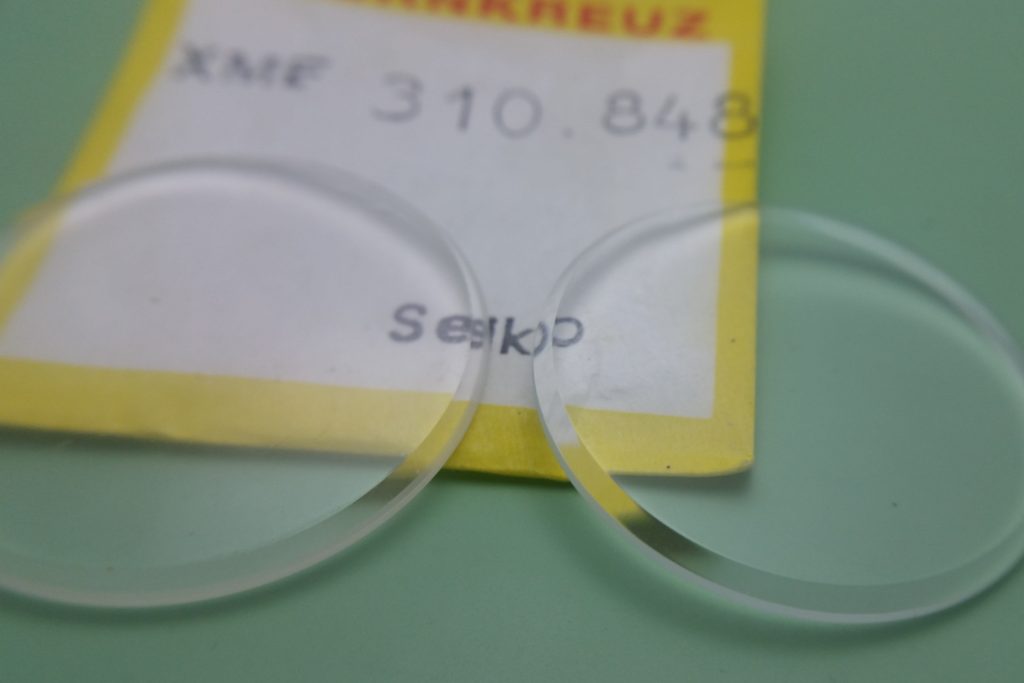
( do not assume it will also work in other 310W13GN cases though ).
The case and bezelBezel Circular ring surrounding, or just inside of, the crystal glass. Sometimes embossed with numbers and rotatable. cleaned up nicely, although no amount of ultrasonicUltrasonic A machine that shakes loose dirt and grease by vibrating the cleaning fluid at very high frequency. cleaning, fiber brushing, or elbow grease was going to remove the pitting and staining under the casebackCaseback The back cover of a watch, usually removable to access the inner workings. track.
My initial interest in this model was piqued due to my having a spare braceletBracelet Metal band/strap to secure a watch around the wrist. in good condition from a previous restoration, albeit in need of a little freshening up. This is easily done for brushed stainless steel with some heavy-duty scouring pad. In the way that blue scourer is used for delicate non-stick pans, and green for regular dishes, there is an extra heavy-duty purple variety, not often seen in stores but readily available online, that will cut through the surface of steel leaving a trim brushed finish.
This braceletBracelet Metal band/strap to secure a watch around the wrist. however, has alternating links of polished and brushed steel. I chose to polish all the center links in one go with a rotary tool and then laboriously mask off rows of links to brush with a pad one at a time….
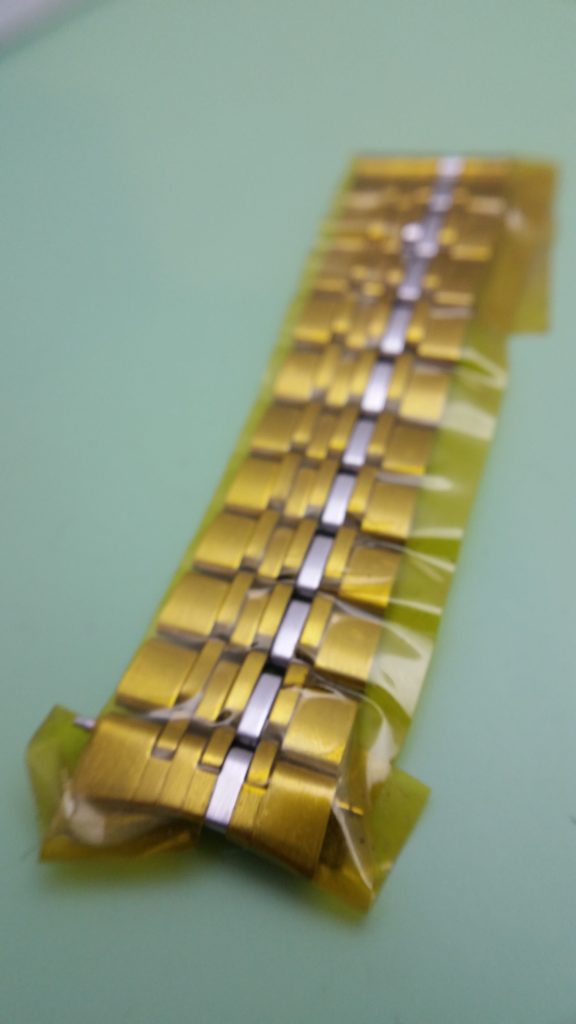
With everything clean and polished its time to drop the movementMovement A noun, referring to the whole of the inner workings of a watch. Not a great choice of word, in my opinion. back in the case, fit fresh, greased rubber gasketsGasket Rubber seal, usually clamped tight, that prevents moisture and dirt from entering the watch. to the casebackCaseback The back cover of a watch, usually removable to access the inner workings. and crownCrown Small, decorative, external control used by the wearer to set time and calendars.
Usually at 3 o'clock., mount a replacement auto rotorRotor A weighted pendulum that moves as the user swings their arm, causing the mainspring to be wound on an automatic watch. in place of the loose original, and snap the back cover into place to sealGasket Rubber seal, usually clamped tight, that prevents moisture and dirt from entering the watch. it all up.
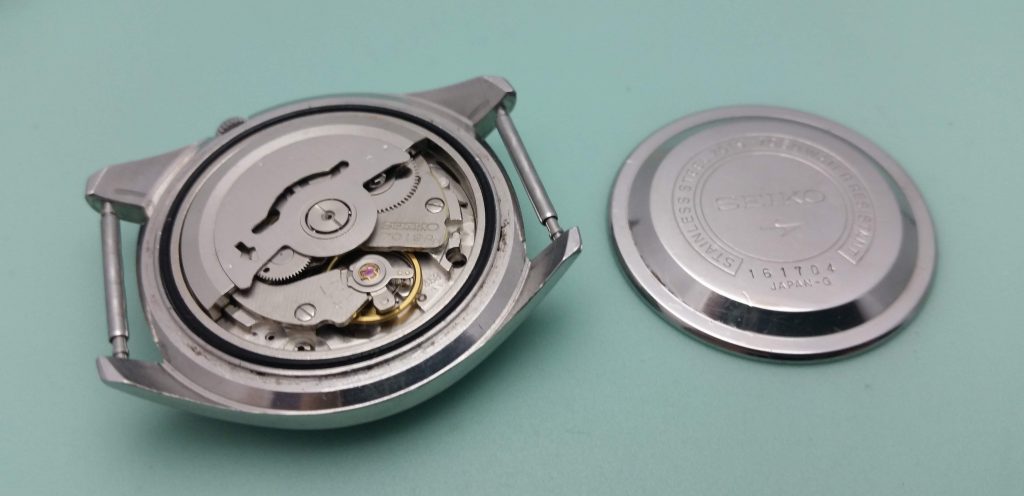
And so the restoration is complete, and all that is left to do is ceremonially strap it to my wrist and enjoy its vintage charms.
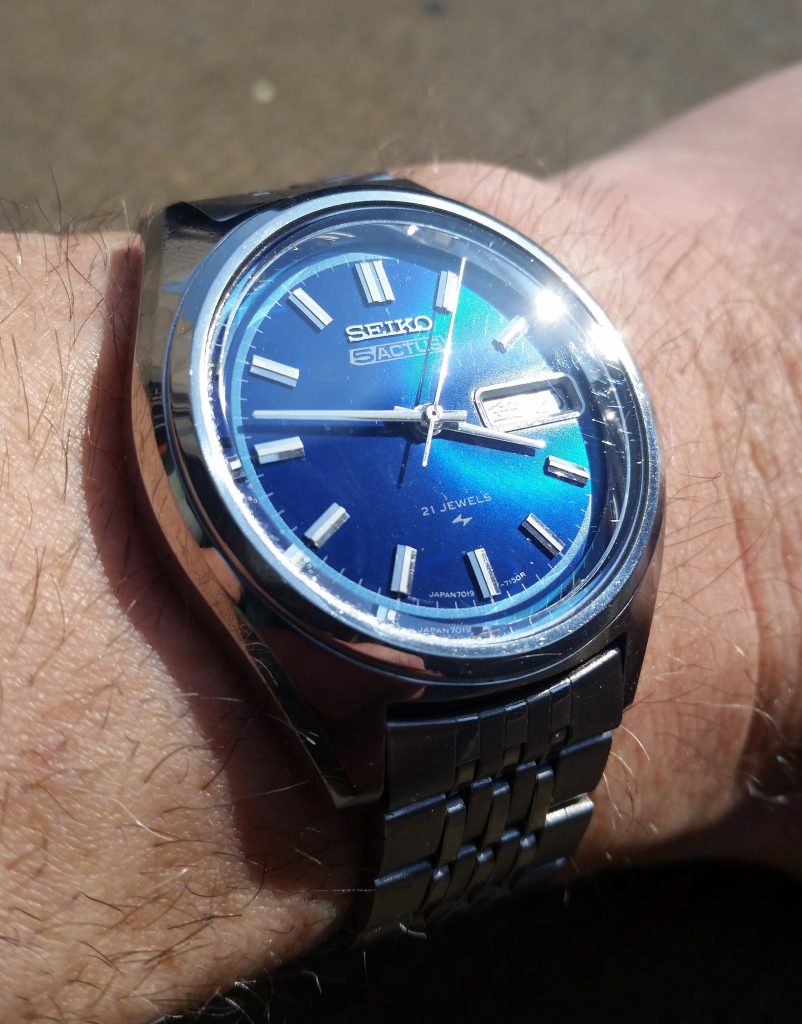
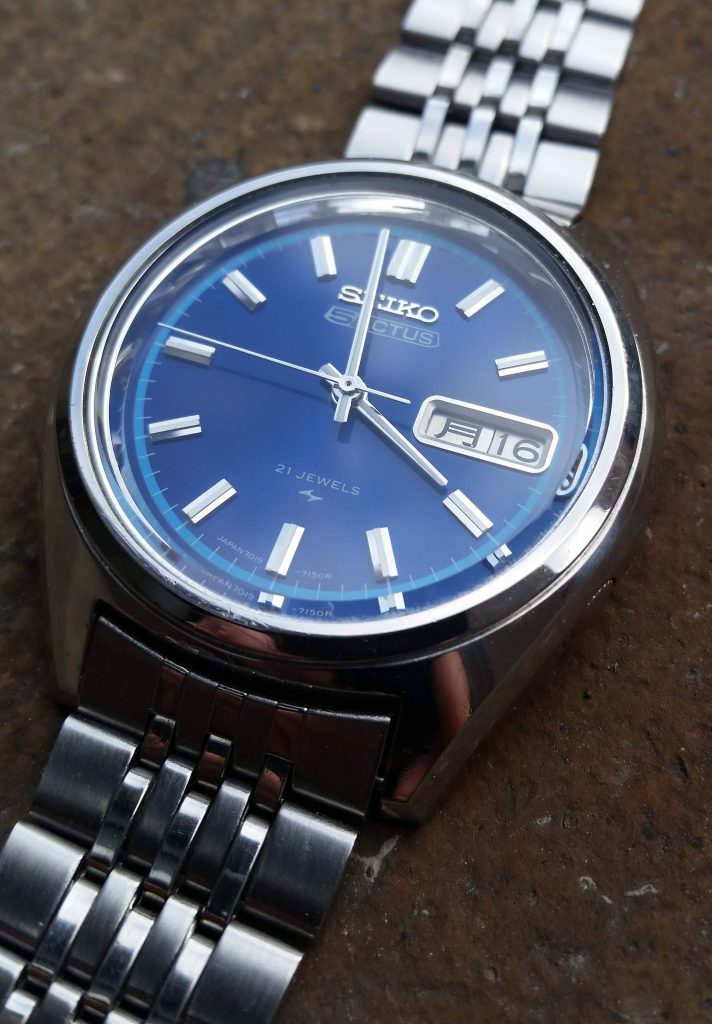
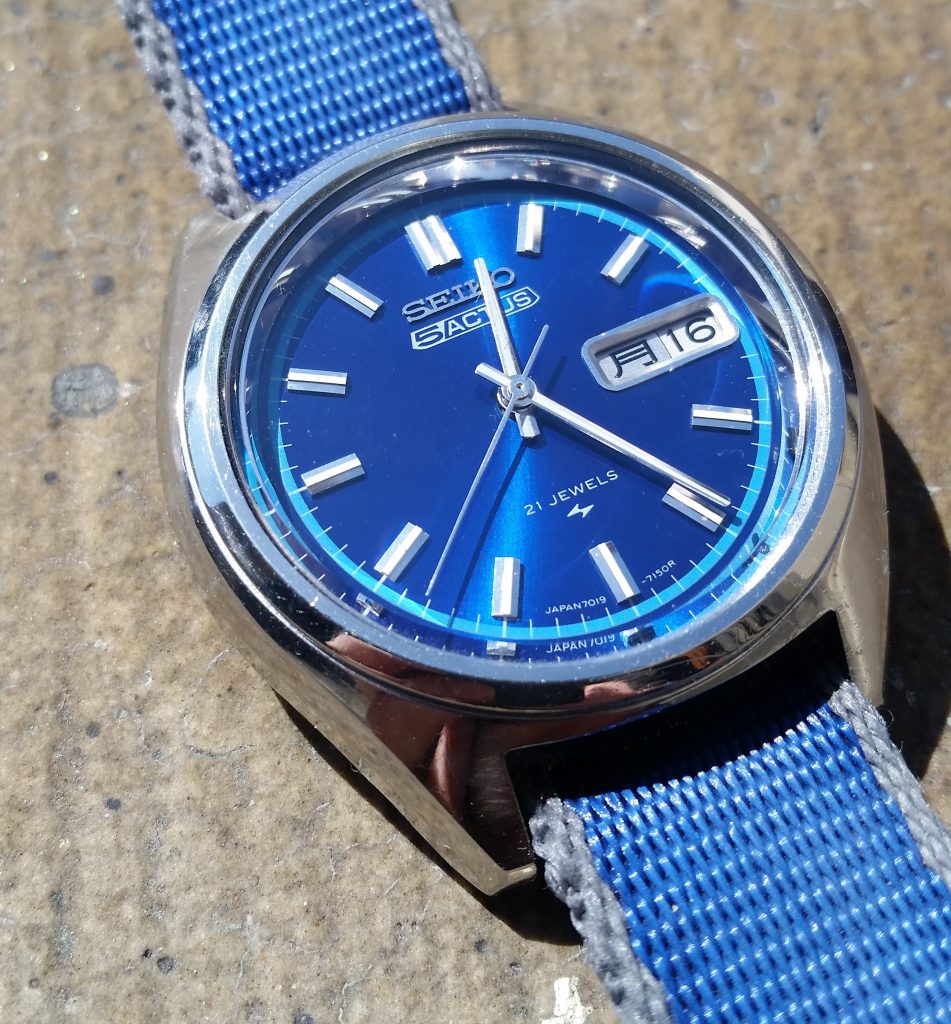
After a few days wear, the regulation of timing can be dialed in to suit my personal pattern of wear & activity, resulting in pleasingly accurate timings:
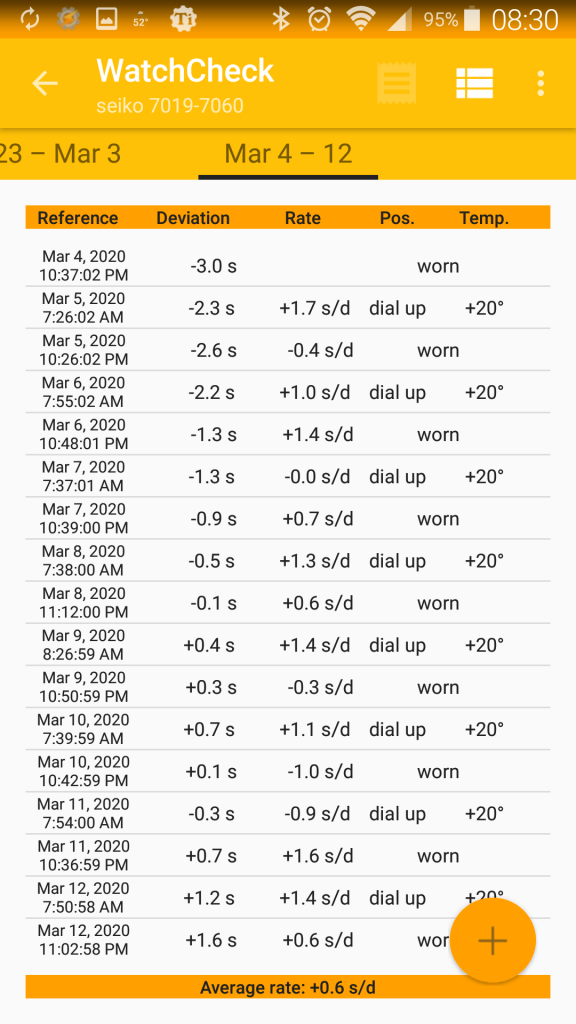
A standard feature on all but the most basic of watches. so I was able to advance the hour without affecting the timing – there’s always a silver lining!
Daily wear shows timings between -0.4 to +1.6 seconds per day.
Overnight on the nightstand, resting dialDial The visible face of the watch. up, shows timings between -0.9 and +1.7 sec/day – curiously a higher variance than when worn.
The overall average for this week of wear was +0.6 s/d, which I’m very pleased with for a timepiece of such humble caliber, and considerable vintage.
Some might say this is a lot of trouble to go to for quite a pedestrian watch – but such is the nature of obsession. It’s taken pride of place on my wrist this past month, dazzling in the spring sunshine, but I really must learn to exercise more diligence at those online auctions…..
Copyright © 2022 HorologyHorology The study of timekeeping. Obsession. All rights reserved.
Suggested reading:
HairspringHairspring Spiral spring that rotates back and forth in the balance wheel, controlling the time keeping of the watch.
Not to be confused with the mainspring which stores the power. manipulation: https://www.youtube.com/watch?v=idO5elKgFMA&t=9s
Dynamic poisingPoise To be uniformly balanced and even.: https://adjustingvintagewatches.com/category/dynamic-posiing/
New parts:
CrystalCrystal The clear glass on the front of a watch.: https://www.cousinsuk.com/product/special-profile-by-brand-model-sternkreuz-xmfo?code=XMF310848

Nice work to get such good timing results for this watch. Impressive!
What an impressive show of knowledge. To a layman hobbyist like me you have unveiled a few mysteries I was wondering about. Thank you.
You took it to a high level of competence… combined with very nice story telling. I enjoyed it a lot. Thank you